Miller Electric Big Blue 602P, Big Blue 402P, Big Blue 502P User Manual
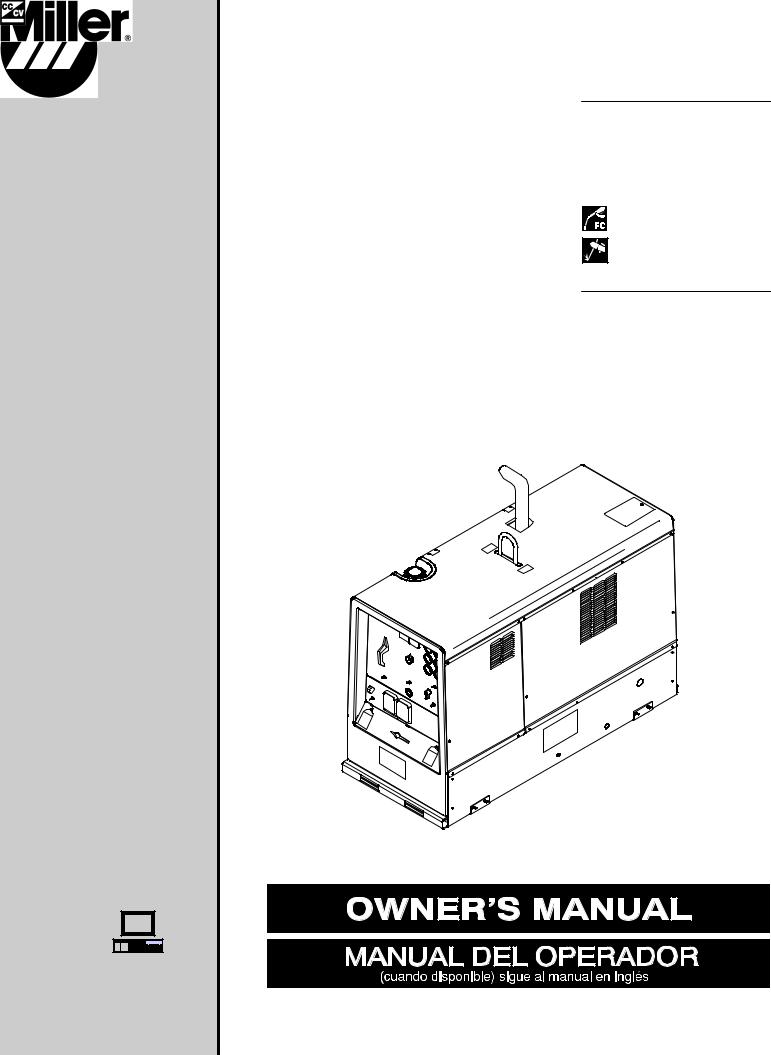
OM-491 |
190 355AP |
October 2003
Processes
Stick (SMAW) Welding
TIG (GTAW) Welding
MIG (GMAW) Welding
Flux Cored (FCAW) Welding
Air Carbon Arc (CAC-A)
Cutting and Gouging
Description
Engine Driven Welding Generator
Big BlueR 402P, 502P, 602P
Visit our website at
www.MillerWelds.com
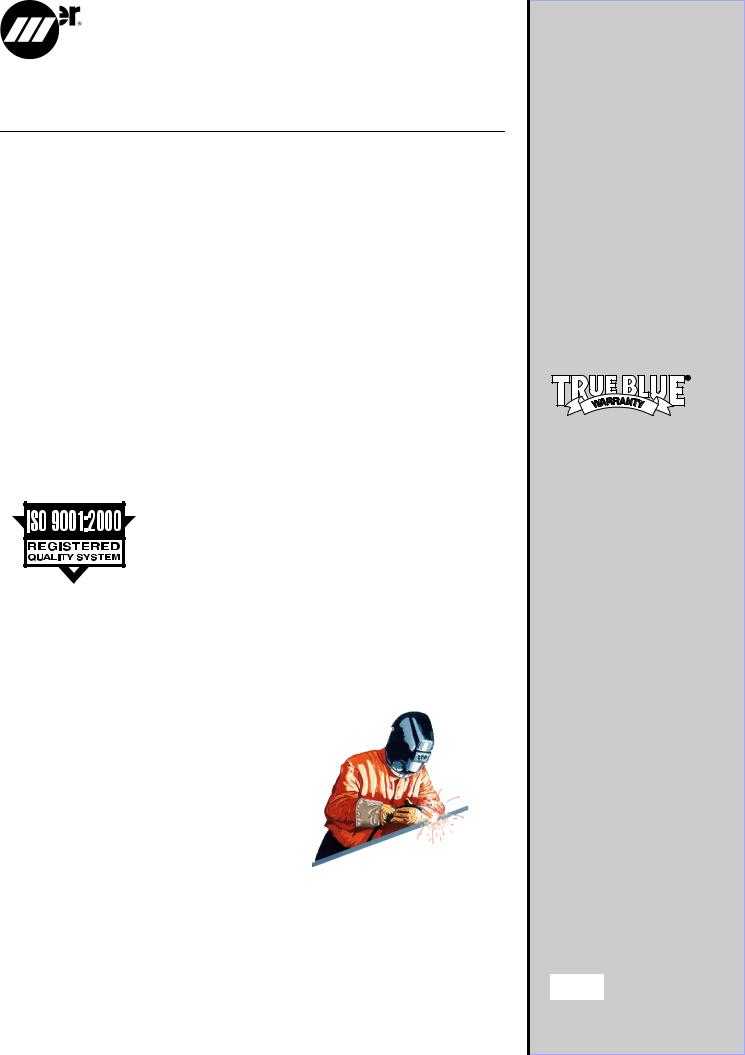
From Miller to You
Thank you and congratulations on choosing Miller. Now you can get the job done and get it done right. We know you don’t have time to do it any other way.
That’s why when Niels Miller first started building arc welders in 1929, he made sure his products offered long-lasting value and superior quality. Like you, his customers couldn’t afford anything less. Miller products had to be more than the best they could be. They had to be the best you could buy.
Today, the people that build and sell Miller products continue the tradition. They’re just as committed to providing equipment and service that meets the high standards of quality and value established in 1929.
This Owner’s Manual is designed to help you get the most out of your Miller products. Please take time to read the Safety precautions. They will help you protect yourself against potential hazards on the worksite.
We’ve made installation and operation quick and easy. With Miller you can count on years of reliable service with proper maintenance.
And if for some reason the unit needs repair, there’s a Troubleshooting section that will help you figure out what the problem is. The parts list will then help you to decide the exact part you may need to fix the problem. Warranty and service information for your particular model are also provided.
Miller Electric manufactures a full line
of welders and welding related equipment. For information on other quality Miller
products, contact your local Miller distributor to receive the latest full line catalog or individual catalog sheets. To locate your nearest distributor or service agency call 1-800-4-A-Miller, or visit us at www.MillerWelds.com on the web.
Mil_Thank 7/03
Working as hard as you do − every power source from Miller is backed by the most hassle-free warranty in the business.

TABLE OF CONTENTS
SECTION 1 − SAFETY PRECAUTIONS − READ BEFORE USING . . . . . . . . . . . . . . . . . . . . . . . . . . . . . . . . . . |
1 |
|
1-1. |
Symbol Usage . . . . . . . . . . . . . . . . . . . . . . . . . . . . . . . . . . . . . . . . . . . . . . . . . . . . . . . . . . . . . . . . . . . . . . . . |
1 |
1-2. |
Arc Welding Hazards . . . . . . . . . . . . . . . . . . . . . . . . . . . . . . . . . . . . . . . . . . . . . . . . . . . . . . . . . . . . . . . . . . |
1 |
1-3. |
Engine Hazards . . . . . . . . . . . . . . . . . . . . . . . . . . . . . . . . . . . . . . . . . . . . . . . . . . . . . . . . . . . . . . . . . . . . . . |
2 |
1-4. |
Compressed Air Hazards . . . . . . . . . . . . . . . . . . . . . . . . . . . . . . . . . . . . . . . . . . . . . . . . . . . . . . . . . . . . . . . |
3 |
1-5. Additional Symbols For Installation, Operation, And Maintenance . . . . . . . . . . . . . . . . . . . . . . . . . . . . . |
3 |
|
1-6. California Proposition 65 Warnings . . . . . . . . . . . . . . . . . . . . . . . . . . . . . . . . . . . . . . . . . . . . . . . . . . . . . . . |
4 |
|
1-7. |
Principal Safety Standards . . . . . . . . . . . . . . . . . . . . . . . . . . . . . . . . . . . . . . . . . . . . . . . . . . . . . . . . . . . . . |
4 |
1-8. |
EMF Information . . . . . . . . . . . . . . . . . . . . . . . . . . . . . . . . . . . . . . . . . . . . . . . . . . . . . . . . . . . . . . . . . . . . . . |
4 |
SECTION 2 − CONSIGNES DE SÉCURITÉ − LIRE AVANT UTILISATION . . . . . . . . . . . . . . . . . . . . . . . . . . . . |
5 |
|
2-1. |
Signification des symboles . . . . . . . . . . . . . . . . . . . . . . . . . . . . . . . . . . . . . . . . . . . . . . . . . . . . . . . . . . . . . |
5 |
2-2. Dangers relatifs au soudage à l’arc . . . . . . . . . . . . . . . . . . . . . . . . . . . . . . . . . . . . . . . . . . . . . . . . . . . . . . |
5 |
|
2-3. Dangers existant en relation avec le moteur . . . . . . . . . . . . . . . . . . . . . . . . . . . . . . . . . . . . . . . . . . . . . . . |
6 |
|
2-4. Dangers liés à l’air comprimé . . . . . . . . . . . . . . . . . . . . . . . . . . . . . . . . . . . . . . . . . . . . . . . . . . . . . . . . . . . |
7 |
|
2-5. Dangers supplémentaires en relation avec l’installation, le fonctionnement et la maintenance . . . . . . |
7 |
|
2-6. Principales normes de sécurité . . . . . . . . . . . . . . . . . . . . . . . . . . . . . . . . . . . . . . . . . . . . . . . . . . . . . . . . . . |
8 |
|
2-7. Information sur les champs électromagnétiques . . . . . . . . . . . . . . . . . . . . . . . . . . . . . . . . . . . . . . . . . . . . |
8 |
|
SECTION 3 − DEFINITIONS . . . . . . . . . . . . . . . . . . . . . . . . . . . . . . . . . . . . . . . . . . . . . . . . . . . . . . . . . . . . . . . . . . . |
9 |
|
3-1. |
Symbols And Definitions . . . . . . . . . . . . . . . . . . . . . . . . . . . . . . . . . . . . . . . . . . . . . . . . . . . . . . . . . . . . . . . |
9 |
SECTION 4 − SPECIFICATIONS . . . . . . . . . . . . . . . . . . . . . . . . . . . . . . . . . . . . . . . . . . . . . . . . . . . . . . . . . . . . . . . . |
9 |
|
4-1. Weld, Power, And Engine Specifications . . . . . . . . . . . . . . . . . . . . . . . . . . . . . . . . . . . . . . . . . . . . . . . . . . 10 4-2. Dimensions, Weights, And Operating Angles . . . . . . . . . . . . . . . . . . . . . . . . . . . . . . . . . . . . . . . . . . . . . . 10 4-3. Volt-Ampere Curves For CC Models . . . . . . . . . . . . . . . . . . . . . . . . . . . . . . . . . . . . . . . . . . . . . . . . . . . . . 11 4-4. Volt-Ampere Curves For CC/CV Models . . . . . . . . . . . . . . . . . . . . . . . . . . . . . . . . . . . . . . . . . . . . . . . . . . 12 4-5. Fuel Consumption . . . . . . . . . . . . . . . . . . . . . . . . . . . . . . . . . . . . . . . . . . . . . . . . . . . . . . . . . . . . . . . . . . . . . 13 4-6. Duty Cycle And Overheating . . . . . . . . . . . . . . . . . . . . . . . . . . . . . . . . . . . . . . . . . . . . . . . . . . . . . . . . . . . . 13 4-7. AC Generator Power Curve . . . . . . . . . . . . . . . . . . . . . . . . . . . . . . . . . . . . . . . . . . . . . . . . . . . . . . . . . . . . . 14
4-8. Optional Three-Phase Generator Curves . . . . . . . . . . . . . . . . . . . . . . . . . . . . . . . . . . . . . . . . . . . . . . . . . 14
SECTION 5 − INSTALLATION . . . . . . . . . . . . . . . . . . . . . . . . . . . . . . . . . . . . . . . . . . . . . . . . . . . . . . . . . . . . . . . . . . |
15 |
5-1. Installing Welding Generator . . . . . . . . . . . . . . . . . . . . . . . . . . . . . . . . . . . . . . . . . . . . . . . . . . . . . . . . . . . . 15 5-2. Mounting Welding Generator . . . . . . . . . . . . . . . . . . . . . . . . . . . . . . . . . . . . . . . . . . . . . . . . . . . . . . . . . . . . 16 5-3. Using Lifting Eye . . . . . . . . . . . . . . . . . . . . . . . . . . . . . . . . . . . . . . . . . . . . . . . . . . . . . . . . . . . . . . . . . . . . . . 17 5-4. Installing Exhaust Pipe . . . . . . . . . . . . . . . . . . . . . . . . . . . . . . . . . . . . . . . . . . . . . . . . . . . . . . . . . . . . . . . . . 17 5-5. Activating The Dry Charge Battery (If Applicable) . . . . . . . . . . . . . . . . . . . . . . . . . . . . . . . . . . . . . . . . . . . 18 5-6. Connecting The Battery . . . . . . . . . . . . . . . . . . . . . . . . . . . . . . . . . . . . . . . . . . . . . . . . . . . . . . . . . . . . . . . . 19
5-7. Engine Prestart Checks . . . . . . . . . . . . . . . . . . . . . . . . . . . . . . . . . . . . . . . . . . . . . . . . . . . . . . . . . . . . . . . . 20 5-8. Connecting To Weld Output Terminals . . . . . . . . . . . . . . . . . . . . . . . . . . . . . . . . . . . . . . . . . . . . . . . . . . . . 21 5-9. Selecting Weld Cable Sizes* . . . . . . . . . . . . . . . . . . . . . . . . . . . . . . . . . . . . . . . . . . . . . . . . . . . . . . . . . . . . 21 5-10. Connecting To Remote Amperage Adjust Receptacle RC13 On CC Models . . . . . . . . . . . . . . . . . . . . . 22
5-11. Connecting To Remote 14 Receptacle RC14 On CC/CV Models . . . . . . . . . . . . . . . . . . . . . . . . . . . . . . 22
SECTION 6 − OPERATING WELDING GENERATOR − CC MODELS . . . . . . . . . . . . . . . . . . . . . . . . . . . . . . . . |
23 |
|
6-1. Front Panel Controls For CC Models (See Section 6-2) . . . . . . . . . . . . . . . . . . . . . . . . . . . . . . . . . . . . . . |
23 |
|
6-2. Description Of Front Panel Controls For CC Models (See Section 6-1) . . . . . . . . . . . . . . . . . . . . . . . . . |
24 |
|
6-3. Remote Amperage Control On CC Models (Optional) . . . . . . . . . . . . . . . . . . . . . . . . . . . . . . . . . . . . . . . |
25 |
|
6-4. Weld Control/Arc Condition Information Label . . . . . . . . . . . . . . . . . . . . . . . . . . . . . . . . . . . . . . . . . . . . . . |
25 |
|
SECTION 7 − OPERATING WELDING GENERATOR − CC/CV MODELS . . . . . . . . . . . . . . . . . . . . . . . . . . . . . |
27 |
|
7-1. |
Front Panel Controls For CC/CV Models (See Section 7-2) . . . . . . . . . . . . . . . . . . . . . . . . . . . . . . . . . . |
27 |
7-2. |
Description Of Front Panel Controls For CC/CV Models (See Section 7-1) . . . . . . . . . . . . . . . . . . . . . . |
28 |
7-3. |
Process/Contactor Switch On CC/CV Models . . . . . . . . . . . . . . . . . . . . . . . . . . . . . . . . . . . . . . . . . . . . . . |
29 |
7-4. |
Remote Voltage/Amperage Control On CC/CV Models (Optional) . . . . . . . . . . . . . . . . . . . . . . . . . . . . . |
30 |

TABLE OF CONTENTS
SECTION 8 |
− OPERATING AUXILIARY EQUIPMENT . . . . . . . . . . . . . . . . . . . . . . . . . . . . . . . . . . . . . . . . . . . . . |
31 |
|
8-1. |
120 Volt And 240 Volt Receptacles . . . . . . . . . . . . . . . . . . . . . . . . . . . . . . . . . . . . . . . . . . . . . . . . . . . . . . . |
31 |
|
8-2. |
Connecting To Optional Three-Phase Generator (CC/CV Models Only) . . . . . . . . . . . . . . . . . . . . . . . . |
32 |
|
8-3. |
Optional Generator Power Receptacles . . . . . . . . . . . . . . . . . . . . . . . . . . . . . . . . . . . . . . . . . . . . . . . . . . . |
33 |
|
SECTION 9 |
− MAINTENANCE & TROUBLESHOOTING . . . . . . . . . . . . . . . . . . . . . . . . . . . . . . . . . . . . . . . . . . . |
34 |
|
9-1. Routine Maintenance . . . . . . . . . . . . . . . . . . . . . . . . . . . . . . . . . . . . . . . . . . . . . . . . . . . . . . . . . . . . . . . . . . 34
9-2. Maintenance Label . . . . . . . . . . . . . . . . . . . . . . . . . . . . . . . . . . . . . . . . . . . . . . . . . . . . . . . . . . . . . . . . . . . . 36
9-3. Servicing Air Cleaner . . . . . . . . . . . . . . . . . . . . . . . . . . . . . . . . . . . . . . . . . . . . . . . . . . . . . . . . . . . . . . . . . . 37 9-4. Inspecting And Cleaning Optional Spark Arrestor Muffler . . . . . . . . . . . . . . . . . . . . . . . . . . . . . . . . . . . . 38
9-5. Adjusting Engine Speed . . . . . . . . . . . . . . . . . . . . . . . . . . . . . . . . . . . . . . . . . . . . . . . . . . . . . . . . . . . . . . . . 39 9-6. Servicing Fuel And Lubrication Systems . . . . . . . . . . . . . . . . . . . . . . . . . . . . . . . . . . . . . . . . . . . . . . . . . . 40
9-7. Overload Protection . . . . . . . . . . . . . . . . . . . . . . . . . . . . . . . . . . . . . . . . . . . . . . . . . . . . . . . . . . . . . . . . . . . 41 9-8. Diagnosing Causes Of Engine Fault Shutdowns . . . . . . . . . . . . . . . . . . . . . . . . . . . . . . . . . . . . . . . . . . . . 42
9-9. Troubleshooting . . . . . . . . . . . . . . . . . . . . . . . . . . . . . . . . . . . . . . . . . . . . . . . . . . . . . . . . . . . . . . . . . . . . . . 43
SECTION 10 − ELECTRICAL DIAGRAMS . . . . . . . . . . . . . . . . . . . . . . . . . . . . . . . . . . . . . . . . . . . . . . . . . . . . . . . |
48 |
|
SECTION 11 − RUN-IN PROCEDURE . . . . . . . . . . . . . . . . . . . . . . . . . . . . . . . . . . . . . . . . . . . . . . . . . . . . . . . . . . . |
52 |
|
11-1. |
Wetstacking . . . . . . . . . . . . . . . . . . . . . . . . . . . . . . . . . . . . . . . . . . . . . . . . . . . . . . . . . . . . . . . . . . . . . . . . . . |
52 |
11-2. |
Run-In Procedure Using Load Bank . . . . . . . . . . . . . . . . . . . . . . . . . . . . . . . . . . . . . . . . . . . . . . . . . . . . . . |
53 |
11-3. |
Run-In Procedure Using Resistance Grid . . . . . . . . . . . . . . . . . . . . . . . . . . . . . . . . . . . . . . . . . . . . . . . . . |
54 |
SECTION 12 − GENERATOR POWER GUIDELINES . . . . . . . . . . . . . . . . . . . . . . . . . . . . . . . . . . . . . . . . . . . . . . |
55 |
|
SECTION 13 − PARTS LIST . . . . . . . . . . . . . . . . . . . . . . . . . . . . . . . . . . . . . . . . . . . . . . . . . . . . . . . . . . . . . . . . . . . |
62 |
|
OPTIONS AND ACCESSORIES |
|
|
WARRANTY |
|
|

SECTION 1 − SAFETY PRECAUTIONS − READ BEFORE USING
rom _nd_8/03
Y Warning: Protect yourself and others from injury — read and follow these precautions.
1-1. Symbol Usage
Means Warning! Watch Out! There are possible hazards with this procedure! The possible hazards are shown in the adjoining symbols.
Y Marks a special safety message.
. Means “Note”; not safety related.
This group of symbols means Warning! Watch Out! possible ELECTRIC SHOCK, MOVING PARTS, and HOT PARTS hazards.
Consult symbols and related instructions below for necessary actions to avoid the hazards.
1-2. Arc Welding Hazards
YThe symbols shown below are used throughout this manual to call attention to and identify possible hazards. When you see the symbol, watch out, and follow the related instructions to avoid the hazard. The safety information given below is only a summary of the more complete safety information found in the Safety Standards listed in Section 1-7. Read and follow all Safety Standards.
YOnly qualified persons should install, operate, maintain, and repair this unit.
YDuring operation, keep everybody, especially children, away.
DUse only well-maintained equipment. Repair or replace damaged parts at once. Maintain unit according to manual.
DWear a safety harness if working above floor level.
DKeep all panels and covers securely in place.
DClamp work cable with good metal-to-metal contact to workpiece or worktable as near the weld as practical.
DInsulate work clamp when not connected to workpiece to prevent contact with any metal object.
DDo not connect more than one electrode or work cable to any single weld output terminal.
ELECTRIC SHOCK can kill.
Touching live electrical parts can cause fatal shocks or severe burns. The electrode and work circuit is electrically live whenever the output is on. The input power circuit and
machine internal circuits are also live when power is on. In semiautomatic or automatic wire welding, the wire, wire reel, drive roll housing, and all metal parts touching the welding wire are electrically live. Incorrectly installed or improperly grounded equipment is a hazard.
DDo not touch live electrical parts.
DWear dry, hole-free insulating gloves and body protection.
DInsulate yourself from work and ground using dry insulating mats or covers big enough to prevent any physical contact with the work or ground.
DDo not use AC output in damp areas, if movement is confined, or if there is a danger of falling.
DUse AC output ONLY if required for the welding process.
DIf AC output is required, use remote output control if present on unit.
DAdditional safety precautions are required when any of the following electrically hazardous conditions are present: in damp locations or while wearing wet clothing; on metal structures such as floors, gratings, or scaffolds; when in cramped positions such as sitting, kneeling, or lying; or when there is a high risk of unavoidable or accidental contact with the workpiece or ground. For these conditions, use the following equipment in order presented: 1) a semiautomatic DC constant voltage (wire) welder, 2) a DC manual (stick) welder, or 3) an AC welder with reduced open-circuit voltage. In most situations, use of a DC, constant voltage wire welder is recommended. And, do not work alone!
DDisconnect input power or stop engine before installing or servicing this equipment. Lockout/tagout input power according to OSHA 29 CFR 1910.147 (see Safety Standards).
DProperly install and ground this equipment according to its Owner’s Manual and national, state, and local codes.
DAlways verify the supply ground — check and be sure that input power cord ground wire is properly connected to ground terminal in disconnect box or that cord plug is connected to a properly grounded receptacle outlet.
DWhen making input connections, attach proper grounding conductor first − double-check connections.
DFrequently inspect input power cord for damage or bare wiring — replace cord immediately if damaged — bare wiring can kill.
DTurn off all equipment when not in use.
DDo not use worn, damaged, undersized, or poorly spliced cables.
DDo not drape cables over your body.
DIf earth grounding of the workpiece is required, ground it directly with a separate cable.
DDo not touch electrode if you are in contact with the work, ground, or another electrode from a different machine.
SIGNIFICANT DC VOLTAGE exists in inverters after stopping engine.
DStop engine on inverter and discharge input capacitors according to instructions in Maintenance Section before touching any parts.
FUMES AND GASES can be hazardous.
Welding produces fumes and gases. Breathing these fumes and gases can be hazardous to your health.
DKeep your head out of the fumes. Do not breathe the fumes.
DIf inside, ventilate the area and/or use exhaust at the arc to remove welding fumes and gases.
DIf ventilation is poor, use an approved air-supplied respirator.
DRead the Material Safety Data Sheets (MSDSs) and the manufacturer’s instructions for metals, consumables, coatings, cleaners, and degreasers.
DWork in a confined space only if it is well ventilated, or while wearing an airsupplied respirator. Always have a trained watchperson nearby. Welding fumes and gases can displace air and lower the oxygen level causing injury or death. Be sure the breathing air is safe.
DDo not weld in locations near degreasing, cleaning, or spraying operations. The heat and rays of the arc can react with vapors to form highly toxic and irritating gases.
DDo not weld on coated metals, such as galvanized, lead, or cadmium plated steel, unless the coating is removed from the weld area, the area is well ventilated, and if necessary, while wearing an air-supplied respirator. The coatings and any metals containing these elements can give off toxic fumes if welded.
BUILDUP OF GAS can injure or kill.
D Shut off shielding gas supply when not in use.
DAlways ventilate confined spaces or use approved air-supplied respirator.
ARC RAYS can burn eyes and skin.
Arc rays from the welding process produce intense visible and invisible (ultraviolet and infrared) rays that can burn eyes and skin. Sparks fly off from the weld.
DWear a welding helmet fitted with a proper shade of filter to protect your face and eyes from arc rays and sparks when welding or watching (see ANSI Z49.1 and Z87.1 listed in Safety Standards).
DWear approved safety glasses with side shields under your helmet.
DUse protective screens or barriers to protect others from flash and glare; warn others not to watch the arc.
DWear protective clothing made from durable, flame-resistant material (wool and leather) and foot protection.
Return To Table Of Contents |
OM-491 Page 1 |
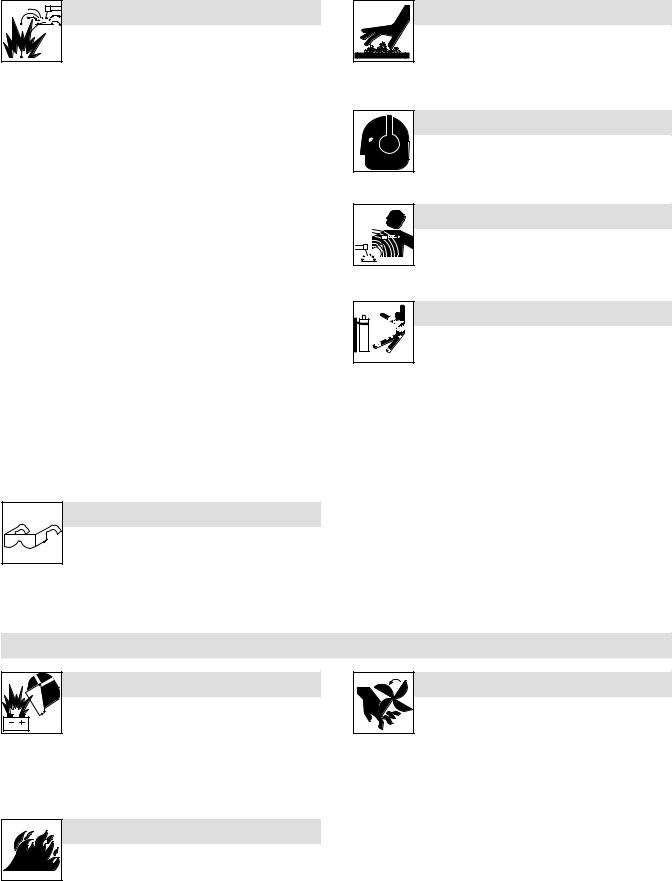
WELDING can cause fire or explosion.
Welding on closed containers, such as tanks, drums, or pipes, can cause them to blow up. Sparks can fly off from the welding arc. The flying sparks, hot workpiece, and hot
equipment can cause fires and burns. Accidental contact of electrode to metal objects can cause sparks, explosion, overheating, or fire. Check and be sure the area is safe before doing any welding.
DProtect yourself and others from flying sparks and hot metal.
DDo not weld where flying sparks can strike flammable material.
DRemove all flammables within 35 ft (10.7 m) of the welding arc. If this is not possible, tightly cover them with approved covers.
DBe alert that welding sparks and hot materials from welding can easily go through small cracks and openings to adjacent areas.
DWatch for fire, and keep a fire extinguisher nearby.
DBe aware that welding on a ceiling, floor, bulkhead, or partition can cause fire on the hidden side.
DDo not weld on closed containers such as tanks, drums, or pipes, unless they are properly prepared according to AWS F4.1 (see Safety Standards).
DConnect work cable to the work as close to the welding area as practical to prevent welding current from traveling long, possibly unknown paths and causing electric shock and fire hazards.
DDo not use welder to thaw frozen pipes.
DRemove stick electrode from holder or cut off welding wire at contact tip when not in use.
DWear oil-free protective garments such as leather gloves, heavy shirt, cuffless trousers, high shoes, and a cap.
DRemove any combustibles, such as a butane lighter or matches, from your person before doing any welding.
DFollow requirements in OSHA 1910.252 (a) (2) (iv) and NFPA 51B for hot work and have a fire watcher and extinguisher nearby.
FLYING METAL can injure eyes.
DWelding, chipping, wire brushing, and grinding cause sparks and flying metal. As welds cool, they can throw off slag.
DWear approved safety glasses with side shields even under your welding helmet.
HOT PARTS can cause severe burns.
DAllow cooling period before maintaining.
D Wear protective gloves and clothing when working on a hot engine.
DDo not touch hot engine parts or just-welded parts bare-handed.
NOISE can damage hearing.
Noise from some processes or equipment can damage hearing.
DWear approved ear protection if noise level is high.
MAGNETIC FIELDS can affect pacemakers.
D Pacemaker wearers keep away.
D Wearers should consult their doctor before going near arc welding, gouging, or spot welding operations.
CYLINDERS can explode if damaged.
Shielding gas cylinders contain gas under high pressure. If damaged, a cylinder can explode. Since gas cylinders are normally part of the welding process, be sure to treat them carefully.
DProtect compressed gas cylinders from excessive heat, mechanical shocks, slag, open flames, sparks, and arcs.
DInstall cylinders in an upright position by securing to a stationary support or cylinder rack to prevent falling or tipping.
DKeep cylinders away from any welding or other electrical circuits.
DNever drape a welding torch over a gas cylinder.
DNever allow a welding electrode to touch any cylinder.
DNever weld on a pressurized cylinder — explosion will result.
DUse only correct shielding gas cylinders, regulators, hoses, and fittings designed for the specific application; maintain them and associated parts in good condition.
DTurn face away from valve outlet when opening cylinder valve.
DKeep protective cap in place over valve except when cylinder is in use or connected for use.
DRead and follow instructions on compressed gas cylinders, associated equipment, and CGA publication P-1 listed in Safety Standards.
1-3. Engine Hazards
BATTERY EXPLOSION can BLIND.
DAlways wear a face shield, rubber gloves, and protec-
tive clothing when working on a battery.
D Stop engine before disconnecting or connecting battery cables or servicing battery.
DDo not allow tools to cause sparks when working on a battery.
DDo not use welder to charge batteries or jump start vehicles.
DObserve correct polarity (+ and −) on batteries.
DDisconnect negative (−) cable first and connect it last.
FUEL can cause fire or explosion.
D Stop engine and let it cool off before checking or adding fuel.
DDo not add fuel while smoking or if unit is near any sparks or open flames.
DDo not overfill tank — allow room for fuel to expand.
DDo not spill fuel. If fuel is spilled, clean up before starting engine.
DDispose of rags in a fireproof container.
DAlways keep nozzle in contact with tank when fueling.
MOVING PARTS can cause injury.
D Keep away from fans, belts, and rotors.
D Keep all doors, panels, covers, and guards closed and securely in place.
DStop engine before installing or connecting unit.
DHave only qualified people remove guards or covers for maintenance and troubleshooting as necessary.
DTo prevent accidental starting during servicing, disconnect negative (−) battery cable from battery.
DKeep hands, hair, loose clothing, and tools away from moving parts.
DReinstall panels or guards and close doors when servicing is finished and before starting engine.
DBefore working on generator, remove spark plugs or injectors to keep engine from kicking back or starting.
DBlock flywheel so that it will not turn while working on generator components.
OM-491 Page 2 |
Return To Table Of Contents |

STEAM AND HOT COOLANT can burn.
DIf possible, check coolant level when engine is cold to avoid scalding.
D Always check coolant level at overflow tank, if present on unit, instead of radiator (unless told otherwise in maintenance section or engine manual).
DIf the engine is warm, checking is needed, and there is no overflow tank, follow the next two statements.
DWear safety glasses and gloves and put a rag over radiator cap.
DTurn cap slightly and let pressure escape slowly before completely removing cap.
ENGINE EXHAUST GASES can kill.
D Use equipment outside in open, well-ventilated areas.
DIf used in a closed area, vent engine exhaust outside
and away from any building air intakes.
BATTERY ACID can BURN SKIN and EYES.
DDo not tip battery.
DReplace damaged battery.
DFlush eyes and skin immediately with water.
ENGINE HEAT can cause fire.
DDo not locate unit on, over, or near combustible surfaces or flammables.
DKeep exhaust and exhaust pipes way from flammables.
EXHAUST SPARKS can cause fire.
DDo not let engine exhaust sparks cause fire.
DUse approved engine exhaust spark arrestor in required areas — see applicable codes.
1-4. Compressed Air Hazards
BREATHING COMPRESSED AIR can cause serious injury or death.
DDo not use compressed air for breathing.
DUse only for cutting, gouging, and tools.
HOT METAL from air arc cutting and gouging can cause fire or explosion.
DDo not cut or gouge near flammables.
DWatch for fire; keep extinguisher nearby.
COMPRESSED AIR can cause injury.
DWear approved safety goggles.
DDo not direct air stream toward self or others.
TRAPPED AIR PRESSURE AND WHIPPING HOSES can cause injury.
DRelease air pressure from tools and system before servicing, adding or changing attachments, or opening compressor oil drain or oil fill cap.
HOT PARTS can cause burns and injury.
DDo not touch hot compressor or air system parts.
DLet system cool down before touching or servicing.
READ INSTRUCTIONS.
DRead Owner’s Manual before using or servicing unit.
DStop engine and release air pressure before servicing.
1-5. Additional Symbols For Installation, Operation, And Maintenance
FALLING UNIT can cause injury.
DUse lifting eye to lift unit only, NOT running gear, gas cylinders, trailer, or any other accessories.
DUse equipment of adequate capacity to lift and support unit.
DIf using lift forks to move unit, be sure forks are long enough to extend beyond opposite side of unit.
OVERUSE can cause OVERHEATING.
DAllow cooling period; follow rated duty cycle.
DReduce current or reduce duty cycle before starting to weld again.
DDo not block or filter airflow to unit.
OVERHEATING can damage motors.
DTurn off or unplug equipment before starting or stopping engine.
DDo not let low voltage and frequency caused by low engine speed damage electric motors.
DDo not connect 50 or 60 Hertz motors to the 100 Hertz receptacle where applicable.
STATIC (ESD) can damage PC boards.
DPut on grounded wrist strap BEFORE handling boards or parts.
DUse proper static-proof bags and boxes to store, move, or ship PC boards.
FLYING SPARKS can cause injury.
D Wear a face shield to protect eyes and face.
D Shape tungsten electrode only on grinder with proper guards in a safe location wearing proper face, hand, and body protection.
DSparks can cause fires — keep flammables away.
Return To Table Of Contents
TILTING OF TRAILER can cause injury.
DUse tongue jack or blocks to support weight.
DProperly install welding generator onto trailer according to instructions supplied with trailer.
OM-491 Page 3
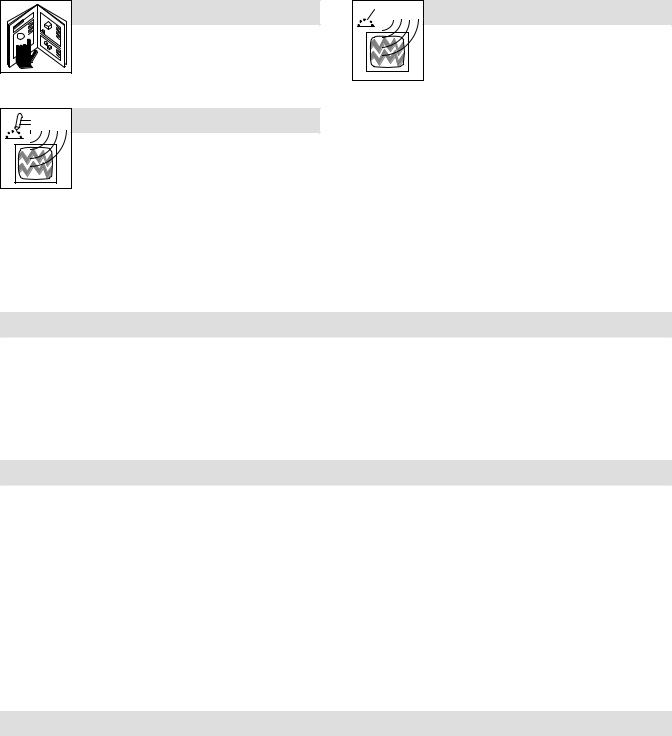
READ INSTRUCTIONS.
D Use only genuine MILLER/Hobart replacement parts.
DPerform engine and air compressor (if applicable) maintenance and service according to this manual and the engine/air compressor (if applicable) manuals.
H.F. RADIATION can cause interference.
DHigh-frequency (H.F.) can interfere with radio navigation, safety services, computers, and communications equipment.
DHave only qualified persons familiar with electronic equipment perform this installation.
D The user is responsible for having a qualified electrician promptly correct any interference problem resulting from the installation.
DIf notified by the FCC about interference, stop using the equipment at once.
DHave the installation regularly checked and maintained.
DKeep high-frequency source doors and panels tightly shut, keep spark gaps at correct setting, and use grounding and shielding to minimize the possibility of interference.
ARC WELDING can cause interference.
DElectromagnetic energy can interfere with sensitive electronic equipment such as microprocessors, computers, and computer-driven equipment such as robots.
DBe sure all equipment in the welding area is electromagnetically compatible.
DTo reduce possible interference, keep weld cables as short as possible, close together, and down low, such as on the floor.
DLocate welding operation 100 meters from any sensitive electronic equipment.
DBe sure this welding machine is installed and grounded according to this manual.
DIf interference still occurs, the user must take extra measures such as moving the welding machine, using shielded cables, using line filters, or shielding the work area.
1-6. California Proposition 65 Warnings
YWelding or cutting equipment produces fumes or gases which contain chemicals known to the State of California to cause birth defects and, in some cases, cancer. (California Health & Safety Code Section 25249.5 et seq.)
YBattery posts, terminals and related accessories contain lead and lead compounds, chemicals known to the State of California to cause cancer and birth defects or other reproductive harm. Wash hands after handling.
For Gasoline Engines:
YEngine exhaust contains chemicals known to the State of California to cause cancer, birth defects, or other reproductive harm.
For Diesel Engines:
YDiesel engine exhaust and some of its constituents are known to the State of California to cause cancer, birth defects, and other reproductive harm.
1-7. Principal Safety Standards
Safety in Welding, Cutting, and Allied Processes, ANSI Standard Z49.1, from American Welding Society, 550 N.W. LeJeune Rd, Miami FL 33126 (phone: 305-443-9353, website: www.aws.org).
Recommended Safe Practices for the Preparation for Welding and Cutting of Containers and Piping, American Welding Society Standard AWS F4.1, from American Welding Society, 550 N.W. LeJeune Rd, Miami, FL 33126 (phone: 305-443-9353, website: www.aws.org).
National Electrical Code, NFPA Standard 70, from National Fire Protection Association, P.O. Box 9101, 1 Battery March Park, Quincy, MA 02269-9101 (phone: 617-770-3000, website: www.nfpa.org and www. sparky.org).
Safe Handling of Compressed Gases in Cylinders, CGA Pamphlet P-1, from Compressed Gas Association, 1735 Jefferson Davis Highway,
Suite 1004, Arlington, VA 22202-4102 (phone: 703-412-0900, website: www.cganet.com).
Code for Safety in Welding and Cutting, CSA Standard W117.2, from Canadian Standards Association, Standards Sales, 178 Rexdale Bou-
levard, Rexdale, Ontario, Canada M9W 1R3 (phone: 800-463-6727 or in Toronto 416-747-4044, website: www.csa-international.org).
Practice For Occupational And Educational Eye And Face Protection,
ANSI Standard Z87.1, from American National Standards Institute, 11 West 42nd Street, New York, NY 10036–8002 (phone: 212-642-4900, website: www.ansi.org).
Standard for Fire Prevention During Welding, Cutting, and Other Hot
Work, NFPA Standard 51B, from National Fire Protection Association, P.O. Box 9101, 1 Battery March Park, Quincy, MA 02269-9101 (phone:
617-770-3000, website: www.nfpa.org and www. sparky.org).
OSHA, Occupational Safety and Health Standards for General Industry, Title 29, Code of Federal Regulations (CFR), Part 1910, Subpart Q, and Part 1926, Subpart J, from U.S. Government Printing Office, Superintendent of Documents, P.O. Box 371954, Pittsburgh, PA 15250 (there are 10 Regional Offices—phone for Region 5, Chicago, is 312-353-2220, website: www.osha.gov).
1-8. EMF Information
Considerations About Welding And The Effects Of Low Frequency Electric And Magnetic Fields
Welding current, as it flows through welding cables, will cause electromagnetic fields. There has been and still is some concern about such fields. However, after examining more than 500 studies spanning 17 years of research, a special blue ribbon committee of the National Research Council concluded that: “The body of evidence, in the committee’s judgment, has not demonstrated that exposure to powerfrequency electric and magnetic fields is a human-health hazard.” However, studies are still going forth and evidence continues to be examined. Until the final conclusions of the research are reached, you may wish to minimize your exposure to electromagnetic fields when welding or cutting.
To reduce magnetic fields in the workplace, use the following procedures:
1.Keep cables close together by twisting or taping them.
2.Arrange cables to one side and away from the operator.
3.Do not coil or drape cables around your body.
4.Keep welding power source and cables as far away from operator as practical.
5.Connect work clamp to workpiece as close to the weld as possible.
About Pacemakers:
Pacemaker wearers consult your doctor first. If cleared by your doctor, then following the above procedures is recommended.
OM-491 Page 4 |
Return To Table Of Contents |

SECTION 2 − CONSIGNES DE SÉCURITÉ − LIRE AVANT UTILISATION
rom_fre 8/03
Y Avertissement: Protégez vous et les autres des blessures − lisez et suivez ces précautions.
2-1. Signification des symboles
Signifie Mise en garde ! Soyez vigilant ! Cette procédure présentedes risques de danger ! Ceux-ci sont identifiés par des symboles adjacents aux directives.
Y Identifie un message de sécurité particulier.
. Signifie NOTA ; n’est pas relatif à la sécurité.
Ce groupe de symboles si-
gnifie Mise en garde !
Soyez vigilant ! Il y a des
 risques de danger reliés aux CHOCS ÉLECTRIQUES, aux PIÈCES EN MOUVEMENT et aux PIÈCES CHAUDES. Reportez-vous aux symboles et aux directives ci-des- sous afin de connaître les mesures à prendre pour éviter tout danger.
risques de danger reliés aux CHOCS ÉLECTRIQUES, aux PIÈCES EN MOUVEMENT et aux PIÈCES CHAUDES. Reportez-vous aux symboles et aux directives ci-des- sous afin de connaître les mesures à prendre pour éviter tout danger.
2-2. Dangers relatifs au soudage à l’arc
YLes symboles présentés ci-après sont utilisés tout au long du présent manuel pour attirer votreattention et identifier les risques de danger. Lorsque vous voyez un symbole, soyez vigilant et suivez les directives mentionnées afin d’éviter tout danger. Les consignes de sécuritéprésentées ci-aprèsne font que résumer l’information contenue dans les normes de sécurité énumérées à la section 2-6.Veuillez lire et respecter toutes ces normes de sécurité.
YL’installation, l’utilisation, l’entretien et les réparations ne doivent être confiés qu’à des personnes qualifiées.
YAu cours de l’utilisation, tenir toute personne à l’écart et plus particulièrement les enfants.
UN CHOC ÉLECTRIQUE peut tuer.
Un simple contact avec des pièces électriques peut provoquer une électrocution ou des blessures graves. L’électrode et le circuit de soudage sont sous tension dès que l’appareil est sur ON. Le circuit d’entrée et les circuits internes de l’appareil sont également sous tension à ce
moment-là. En soudage semi-automatique ou automatique, le fil, le dévidoir, le logement des galets d’entraînement et les pièces métalliques en contact avec le fil de soudage sont sous tension. Des matériels mal installés ou mal mis à la terre présentent un danger.
DNe jamais toucher les pièces électriques sous tension.
DPorter des gants et des vêtements de protection secs ne comportant pas de trous.
DS’isoler de la pièce et de la terre au moyen de tapis ou d’autres moyens isolants suffisamment grands pour empêcher le contact physique éventuel avec la pièce ou la terre.
DNe pas se servir de source électrique àcourant électrique dans les zones humides, dans les endroits confinés ou là où on risque de tomber.
DSe servir d’une source électrique àcourant électrique UNIQUEMENT si le procédé desoudage le demande.
DSi l’utilisation d’une source électrique àcourant électrique s’avère nécessaire, se servir de la fonction de télécommande si l’appareil en est équipé.
DDes précautions de sécurité supplémentairessont requises dans des environnements à risque comme: les endroits humides ou lorsque l’on porte des vêtements mouillés; sur des structures métalliques au sol, grillages et échafaudages; dans des positions assises, à genoux et allongées; ou quand il y a un risque important de contact accidentel avec la pièce ou le sol. Dans ces cas utiliser les appareils suivants dans l’ordre de préférence: 1) un poste à souder DC semi−automatique de type CV (MIG/MAG), 2) un poste à souder manuel (électrode enrobée) DC, 3) un poste à souder manuel AC avec tension à vide réduite. Dans la plupart des cas, un poste courant continu de type CV est recommandé. Et, ne pas travailler seul!
DCouper l’alimentation ou arrêter le moteur avant de procéder à l’installation, à la réparation ou à l’entretien de l’appareil. Déverrouiller l’alimentation selon la norme OSHA 29 CFR 1910.147 (voir normes de sécurité).
DInstaller et mettre à la terre correctement cet appareil conformément à son manuel d’utilisation et aux codes nationaux, provinciaux et municipaux.
DToujours vérifier la terre du cordon d’alimentation − Vérifier et s’assurer que le fil de terre du cordon d’alimentation est bien raccordé à la borne de terre du sectionneur ou que la fiche du cordon est raccordée à une prise correctement mise à la terre.
DEn effectuant les raccordements d’entrée fixer d’abord le conducteur de mise à la terre approprié et contre-vérifier les connexions.
DVérifier fréquemment le cordon d’alimentation pour voir s’il n’est pas endommagé ou dénudé − remplacer le cordon immédiatement s’il est endommagé − un câble dénudé peut provoquer une électrocution.
DMettre l’appareil hors tension quand on ne l’utilise pas.
DNe pas utiliser des câbles usés, endommagés, de grosseur insuffisante ou mal épissés.
DNe pas enrouler les câbles autour du corps.
DSi la pièce soudée doit être mise à la terre, le faire directement avec un câble distinct − ne pas utiliser le connecteur de pièce ou le câble de retour.
DNe pas toucher l’électrodequand on est en contact avec la pièce, la terre ou une électrode provenant d’une autre machine.
DN’utiliser qu’un matériel en bon état. Réparer ou remplacer sur-le-champ les pièces endommagées. Entretenir l’appareil conformément à ce manuel.
DPorter un harnais de sécurité quand on travaille en hauteur.
DMaintenir solidement en place tous les panneaux et capots.
DFixer le câble de retour de façon à obtenir un bon contact métal-métal avec la pièce à souder ou la table de travail, le plus près possible de la soudure.
DIsoler la pince de masse quand pas mis à la pièce pour éviter le contact avec tout objet métallique.
Une tension DC importante subsiste à l’intérieur des onduleurs après avoir coupé l’alimentation.
DCouper l’alimentation du poste et décharger les condensateurs d’entrée comme indiqué dans la Section Maintenance avant de toucher des composants.
LES FUMÉES ET LES GAZ peuvent être dangereux.
Le soudage génère des fuméeset des gaz. Leur inhalation peut être dangereux pour votre santé.
DEloigner votre tête des fumées. Ne pas respirer les fumées.
DÀ l’interieur, ventiler la zone et/ou utiliser un échappement au niveau de l’arc pour l’évacuation des fumées et des gaz de soudage.
DSi la ventilation est insuffisante, utiliser un respirateur à alimentation d’air homologué.
DLire les spécifications de sécurité des matériaux (MSDSs) et les instructions du fabricant concernant les métaux, les consommables, les revêtements, les nettoyants et les dégraisseurs.
DTravailler dans un espace fermé seulement s’il est bien ventilé ou en portant un respirateur à alimentation d’air. Demander toujours à un surveillant dûment formé de se tenir à proximité. Des fumées et des gaz de soudage peuvent déplacer l’air et abaisser le niveau d’oxygène provoquant des blessures ou des accidents mortels. S’assurer que l’air de respiration ne présente aucun danger.
DNe pas souder dans des endroits situés à proximité d’opérations de dégraissage, de nettoyage ou de pulvérisation. La chaleur et les rayons de l’arc peuvent réagir en présence de vapeurs et former des gaz hautement toxiques et irritants.
DNe pas souder des métaux munis d’un revêtement, tels que l’acier galvanisé, plaqué en plomb ou au cadmium à moins que le revêtement n’ait été enlevé dans la zone de soudure, que l’endroit soit bien ventilé, et si nécessaire, en portant un respirateur à alimentation d’air. Les revêtements et tous les métaux renfermant ces éléments peuvent dégager des fumées toxiques en cas de soudage.
Revenez à la table des matières |
OM-491 Page 5 |
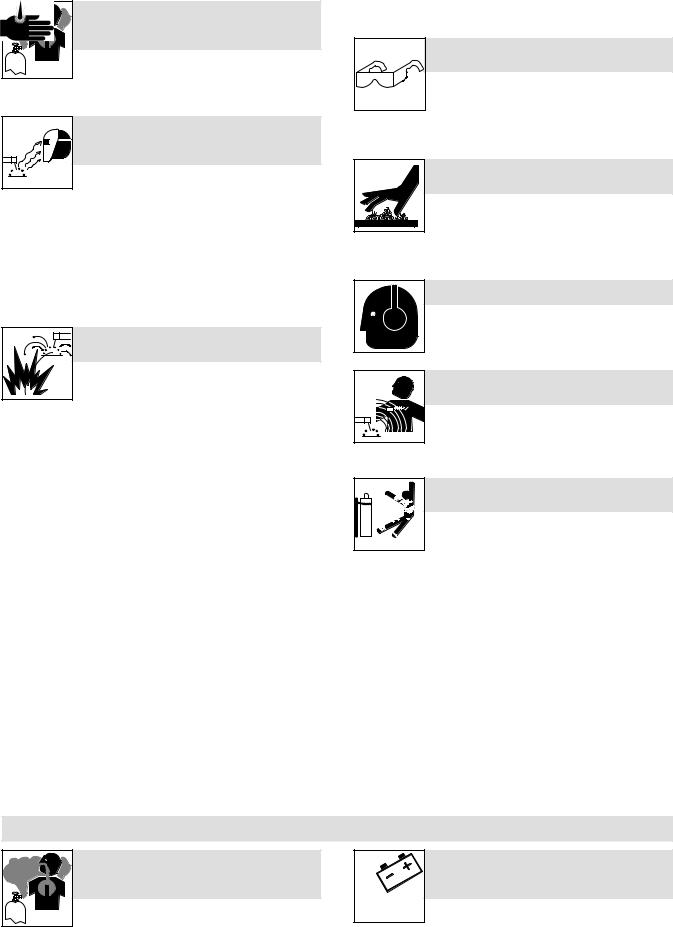
LES ACCUMULATIONS DE GAZ risquent de provoquer des blessures ou même la mort.
DFermer l’alimentation du gaz protecteur en cas de non utilisation.
DVeiller toujours à bien aérer les espaces confinés ou se servir d’un respirateur d’adduction d’air homologué.
LES RAYONS DE L’ARC peuvent provoquer des brûlures dans les yeux et sur la peau.
Le rayonnement de l’arc du procédé de soudage génère des rayons visibles et invisibles intenses (ultraviolets et
infrarouges) susceptibles de provoquer des brûlures dans les yeux et sur la peau. Des étincelles sont projetées pendant le soudage.
DPorter un casque de soudage muni d’un écran de filtre approprié pour protéger votre visage et vos yeux pendant le soudage ou pour regarder (voir ANSI Z49.1 et Z87.1 énuméré dans les normes de sécurité).
DPorter des protections approuvés pour les oreilles si le niveau sondre est trop élevé.
DUtiliser des écrans ou des barrièrespour protéger des tiers de l’éclair et de l’éblouissement; demander aux autres personnes de ne pas regarder l’arc.
DPorter des vêtements de protection constitué dans une matière durable, résistant au feu (laine ou cuir) et une protection des pieds.
LE SOUDAGE peut provoquer un incendie ou une explosion.
Le soudage effectué sur des conteneurs fermés tels que  des réservoirs, tambours ou des conduites peut provoquer leur éclatement. Des étincelles peuvent être projetées de l’arc de soudure. La projection d’étincelles, des pièces chaudes et des
des réservoirs, tambours ou des conduites peut provoquer leur éclatement. Des étincelles peuvent être projetées de l’arc de soudure. La projection d’étincelles, des pièces chaudes et des
équipementschauds peut provoquer des incendies et des brûlures. Le contact accidentel de l’électrode avec des objets métalliques peut provoquer des étincelles, une explosion, un surchauffement ou un incendie. Avant de commencer le soudage, vérifier et s’assurer que l’endroit ne présente pas de danger.
DSe protéger et d’autres personnes de la projection d’étincelles et demétal chaud.
DNe pas souder dans un endroit là où des étincelles peuvent tomber sur des substances inflammables.
DDéplacer toutes les substances inflammables à une distance de 10,7 m de l’arc de soudage. En cas d’impossibilité les recouvrir soigneusement avec des protections homologués.
DDes étincelles et des matériaux chauds du soudage peuvent facilement passer dans d’autres zones en traversant de petites fissures et des ouvertures.
DSurveiller tout déclenchement d’incendie et tenir un extincteur à proximité.
DLe soudage effectué sur un plafond, plancher, paroi ou séparation peut déclencher un incendie de l’autre côté.
DNe pas effectuer le soudage sur des conteneurs fermés tels que des réservoirs, tambours, ou conduites, à moins qu’ils n’aient été préparés correctement conformément à AWS F4.1 (voir les normes de sécurité).
DBrancher le câble sur la pièce le plus près possible de la zone de soudage pour éviter le transport du courant sur une longue distance par des chemins inconnus éventuels en provoquant des risques d’électrocution et d’incendie.
DNe pas utiliser le poste de soudage pour dégeler des conduites gelées.
DEn cas de non utilisation, enlever la baguette d’électrode du porte-électro- de ou couper le fil à la pointe de contact.
DPorter des vêtements de protection dépourvus d’huile tels que des gants en cuir, une chemise en matériau lourd, des pantalons sans revers, des chaussures hautes et un couvre chef.
DAvant de souder, retirer toute substance combustible de vos poches telles qu’un allumeur au butane ou des allumettes.
DSuivre les recommandations dans OSHA 1910.252(a)(2)(iv) et NFPA 51B pour les travaux à chaud et avoir de la surveillance et un extincteur à proximité.
DES PARTICULES VOLANTES peuvent blesser les yeux.
D Le soudage, l’écaillement, le passage de la pièce à la brosse en fil de fer, et le meulage génèrent des étincelles et des particules métalliques vo-
lantes. Pendant la période de refroidissement des soudures, elles risquent de projeter du laitier.
DPorter des lunettes de sécurité avec écranslatéraux ou un écran facial.
DES PIÈCES CHAUDES peuvent provoquer des brûlures graves.
D Prévoir une période de refroidissement avant d’effectuer des travaux d’entretien.
DPorter des gants et des vêtements de protection pour travailler sur un moteur chaud.
DNe pas toucher à mains nues les parties chaudes du moteur ni les pièces récemment soudées.
LE BRUIT peut affecter l’ouïe.
Le bruit des processus et des équipements peut affecter l’ouïe.
DPorter des protections approuvés pour les oreilles si le niveau sondre est trop élevé.
LES CHAMPS MAGNÉTIQUES peuvent affecter les stimulateurs cardiaques.
D Porteurs de stimulateur cardiaque, restez à distance.
D Les porteurs d’un stimulateur cardiaque doivent d’abord consulter leur médecin avant de s’approcher des opérations de soudage à l’arc, de gougeage ou de soudage par points.
Si des BOUTEILLES sont endommagées, elles pourront exploser.
Des bouteilles de gaz protecteur contiennent du gaz sous haute pression. Si une bouteille est endommagée, elle peut exploser. Du fait que les bouteilles de gaz font normalement partie du procédé de soudage, les manipuler avec précaution.
DProtéger les bouteilles de gaz comprimé d’une chaleur excessive, des chocs mécaniques, du laitier, des flammes ouvertes, des étincelles et des arcs.
DPlacer les bouteilles debout en les fixant dans un support stationnaire ou dans un porte-bouteilles pour les empêcher de tomber ou de se renverser.
DTenir les bouteilles éloignées des circuits de soudage ou autres circuits électriques.
DNe jamais placer une torche de soudage sur une bouteille à gaz.
DUne électrode de soudage ne doit jamais entrer en contact avec une bouteille.
DNe jamais souder une bouteille pressurisée − risque d’explosion.
DUtiliser seulement des bouteilles de gaz protecteur, régulateurs, tuyaux et raccords convenables pour cette application spécifique; les maintenir ainsi que les éléments associés en bon état.
DNe pas tenir la tête en face de la sortie en ouvrant la soupape de la bouteille.
DMaintenir le chapeau de protection sur la soupape, sauf en cas d’utilisation ou de branchement de la bouteille.
DLire et suivre les instructions concernant les bouteilles de gaz comprimé, les équipements associés et les publication P-1 CGA énumérées dans les normes de sécurité.
2-3. Dangers existant en relation avec le moteur
LES ACCUMULATIONS DE GAZ risquent de provoquer des blessures ou même la mort.
DFermer l’alimentation du gaz protecteur en cas de non utilisation.
DVeiller toujours à bien aérer les espaces confinés ou se servir d’un respirateur d’adduction d’air homologué.
L’ACIDE DE LA BATTERIE peut provoquer des brûlures dans les YEUX et sur la PEAU.
DNe pas renverser la batterie.
DRemplacer une batterie endommagée.
DRincer immédiatement les yeux et la peau à l’eau.
OM-491 Page 6 |
Revenez à la table des matières |
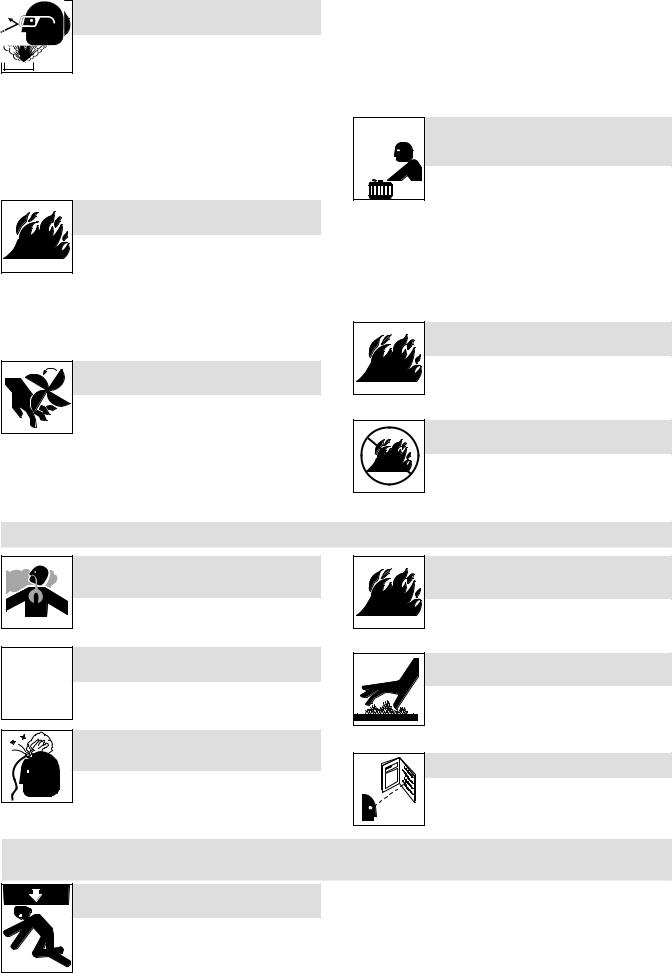
L’EXPLOSION DE LA BATTERIE peut
RENDRE AVEUGLE.
D Toujours porter une protection faciale, des gants en caoutchouc et vêtements de protection lors d’une intervention sur la batterie.
DArrêter le moteur avant de débrancher ou de brancher les câbles de batterie.
DEviter de provoquer des étincelles avec les outils en travaillant sur la batterie.
DNe pas utiliser le poste de soudage pour charger les batteries ou des véhicules de démarrage rapide.
DObserver la polarité correcte (+ et −) sur les batteries.
DDébrancher le câble négatif (–) en premier lieu. Le rebrancher en dernier lieu.
LE CARBURANT MOTEUR peut provoquer un incendie ou une explosion.
DArrêter le moteur avant de vérifier le niveau de carburant ou de faire le plein.
DNe pas faire le plein en fumant ou proche d’une source d’étincelles ou d’une flamme nue.
DNe pas faire le plein de carburant à ras bord; prévoir de l’espace pour son expansion.
DFaire attention de ne pas renverser de carburant. Nettoyer tout carburant renversé avant de faire démarrer le moteur.
DJeter les chiffons dans un récipient ignifuge.
DES ORGANES MOBILES peuvent provoquer des blessures.
D Ne pas approcher les mains des ventilateurs, courroies et autres pièces en mouvement.
DMaintenir fermés et fixement en place les portes, panneaux, recouvrements et dispositifs de protection.
DArrêter le moteur avant d’installer ou brancher l’appareil.
DDemander seulement à un personnel qualifié d’enlever les dispositifs de sécurité oules recouvrements pour effectuer, s’il y a lieu, des travaux d’entretien et de dépannage.
DPour empêcher tout démarrage accidentel pendant les travaux d’entretien, débrancher le câble négatif (−) de batterie de la borne.
DNe pas approcher les mains, cheveux, vêtements lâches et outils des organes mobiles.
DRemettre en place les panneaux ou les dipositifs de protection et fermer les portes à la fin des travaux d’entretien et avant de faire démarrer le moteur.
DAvant d’intervenir, déposer les bougies ou injecteurs pour éviter la mise en route accidentelle du moteur.
DBloquer le volant moteur pour éviter sa rotation lors d’une intervention sur le générateur.
LA VAPEUR ET LE LIQUIDE DE REFROIDISSEMENT CHAUD peuvent provoquer des brûlures.
D Il est préférable de vérifier le liquide de refroidissement une fois le moteur refroidi pour éviter de se brûler.
DToujours vérifier le niveau de liquide de refroidissement dans le vase d’expansion (si présent), et non dans le radiateur (sauf si précisé autrement dans la section maintenance du manuel du moteur).
DSi le moteur est chaud et que le liquide doit être vérifié, opérer comme suivant :
DMettre des lunettes de sécurité et des gants, placer un torchon sur le bouchon du radiateur.
DDévisser le bouchon légèrement et laisser la vapeur s’échapper avant d’enlever le bouchon.
LA CHALEUR DU MOTEUR peut provoquer un incendie.
DNe pas placer l’appareil sur, au-dessus ou à proximité de surfaces inflammables.
DTenir à distance les produits inflammables de l’échappement.
LES ÉTINCELLES À L ’ÉCHAPPEMENT peuvent provoquer un incendie.
DEmpêcher les étincelles d’échappement du moteur de provoquer un incendie.
DUtiliser uniquement un pare-étincelles approuvé − voir codes en vigueur.
2-4. Dangers liés à l’air comprimé
RESPIRER L’AIR COMPRIMÉ peut pro - voquer des blessures graves ou causer la mort.
DNe pas utiliser l’air comprimé pour respirer.
DUtiliser l’air comprimé seulement pour le coupage, gougeage et les outils pneumatiques.
Le METAL CHAUD lors du coupage et gougeage plasma peut provoquer un incendie ou une explosion.
DNe pas couper ou gouger à proximité de produits inflammables.
DSurveillez et garder un extincteur à proximité.
L’AIR COMPRIMÉ peut provoque r des blessures.
DPorter des lunettes de sécurité approuvées.
DNe pas diriger le jet d’air vers d’autres ou soi− même.
L’AIR COMPRIME EMMAGASINE ET DES TUYAUX SOUS PRESSION peuvent provoquer des blessures.
DRelâcher la pression d’air de l’outillage ou du système avant d’effectuer la maintenance, avant de changer ou de rajouter des éléments ou avant d’ouvrir la purge ou le bouchon de remplissage d’huile.
DES PIECES CHAUDES peuvent provoquer des brûlures et blessures.
DNe pas toucher le compresseur ou d’autres éléments du circuit air comprimé chauds.
DLaisser l’ensemble se refroidir avant de toucher ou d’effectuer la maintenance.
LIRE LES INSTRUCTIONS.
DLisez le manuel d’instructions avant l’utilisation ou la maintenance de l’appareil.
DArrêter le moteur et relâcher la pression avant d’effectuer la maintenance.
2-5. Dangers supplémentaires en relation avec l’installation, le fonctionnement et la maintenance
LA CHUTE DE L’APPAREIL peut blesser.
DUtiliser l’anneau de levage uniquement pour soulever l’appareil lui-même ; sans chariot, de bouteilles de gaz, remorque, ou autres accessoires.
DUtiliser un équipement de levage de capacité suffisante pour lever l’appareil.
DEn utilisant des fourches de levage pour déplacer l’unité, s’assurer que les fourches sont suffisamment longues pour dépasser du côté opposé de l’appareil.
Revenez à la table des matières |
OM-491 Page 7 |
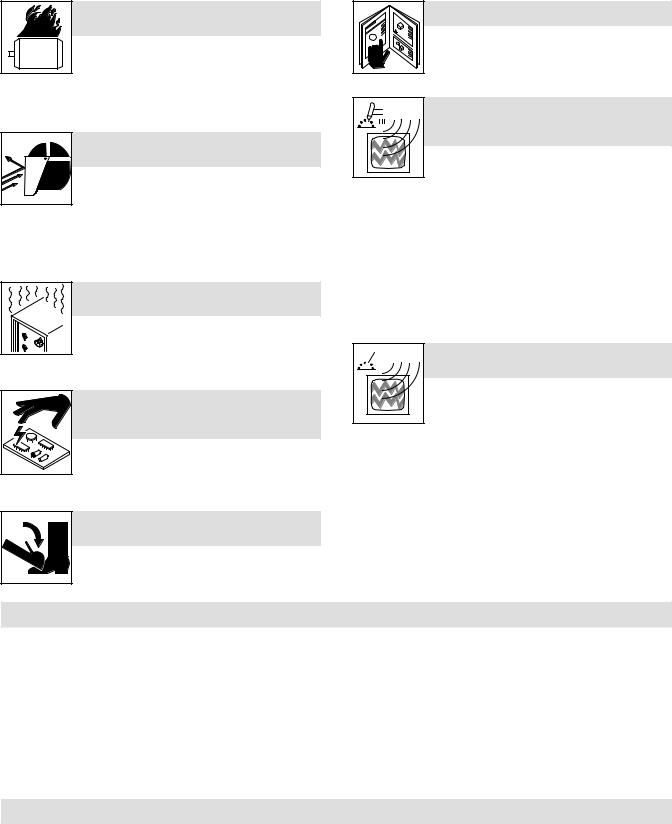
LE SURCHAUFFEMENT peut endommager le moteur électrique.
DArrêter ou déconnecter l’équipement avant de démarrer ou d’arrêter le moteur.
DNe pas laisser tourner le moteur trop lentement sous risque d’endommager le moteur électrique à cause d’une tension et d’une fréquence trop faibles.
DNe pas brancher de moteur de 50 ou de 60 Hz à la prise de 100 Hz, s’il y a lieu.
LES ÉTINCELLES VOLANTES risquent de provoquer des blessures.
D Porter un écran facial pour protéger le visage et les yeux.
DAffuterr l’électrode au tungstène uniquement à lameuleuse dotée de protecteurs. Cette manoeuvre est à exécuter dans un endroit sûr lorsque l’on porte l’équipement homologué deprotection du visage, des mains et du corps.
DLes étincelles risquent de causer un incendie − éloigner toute substance inflammable.
L’EMPLOI EXCESSIF peut
SURCHAUFFER L’ÉQUIPEMENT.
DLaisser l’équipement refroidir ; respecter lefacteur de marche nominal.
DRéduire le courant ou le facteur de marche avant de poursuivre le soudage.
DNe pas obstruer les passages d’air du poste.
LES CHARGES ÉLECTROSTATIQUES peuvent endommager les circuits imprimés.
D Établir laconnexion avec la barrette de terre avant de manipuler des cartes ou des pièces.
DUtiliser des pochettes et des boîtes antistatiques pour stocker, déplacer ou expédier des cartes de circuits imprimes.
UNE REMORQUE QUI BASCULE peut entraîner des blessures.
D Utiliser les supports de la remorque ou des blocs pour soutenir le poids.
DInstaller convenablement le poste sur la remorque comme indiqué dans le manuel s’y rapportant.
LIRE LES INSTRUCTIONS.
D Utiliser seulement les pièces de rechange d’origine.
DEffectuer la maintenance du moteur et du compresseur (si applicable) suivant ce manuel et le manuel du moteur/compresseur (si applicable).
LE RAYONNEMENT HAUTE FRÉQUENCE (H.F.) risque de provoquer des interférences.
D Le rayonnement haute fréquence (H.F.) peut provoquer des interférences avec les équipements de radio−navigation et de communication, les services de sécurité et les ordinateurs.
DDemander seulement à des personnes qualifiées familiarisées avec des équipementsélectroniques de faire fonctionner l’installation.
DL’utilisateur est tenu de faire corriger rapidement par un électricien qualifié les interférences résultant de l’installation.
DSi le FCC signale des interférences, arrêter immédiatement l’appareil.
DEffectuer régulièrement le contrôle et l’entretien de l’installation.
DMaintenir soigneusement fermés les portes et les panneaux des sources de haute fréquence, maintenir les éclateurs à une distance correcte et utiliser une terre et et un blindage pour réduire les interférences éventuelles.
LE SOUDAGE À L’ARC risque de provoquer des interférences.
D L’énergie électromagnétique risque de provoquer des interférences pour l’équipement électronique sensible tel que les ordinateurs et l’équipement commandé par ordinateur tel que les robots.
DVeiller à ce que tout l’équipement de la zone de soudage soit compatible électromagnétiquement.
DPour réduire la possibilité d’interférence, maintenir les câbles de soudage aussi courts que possible, les grouper, et les poser aussi bas que possible (ex. par terre).
DVeiller à souder à une distance de 100 mètres de tout équipement électronique sensible.
DVeiller à ce que ce poste de soudage soit posé et mis à la terre conformément à ce mode d’emploi.
DEn cas d’interférences après avoir pris les mesures précédentes, il incombe à l’utilisateur de prendre des mesures supplémentaires telles que le déplacement du poste, l’utilisation de câbles blindés, l’utilisation de filtres de ligne ou la pose de protecteurs dans la zone de travail.
2-6. Principales normes de sécurité
Safety in Welding, Cutting, and Allied Processes, norme ANSI Z49.1, de l’American Welding Society, 550 N.W. LeJeune Rd, Miami FL 33126 (téléphone : (305) 443−9353, site Web : www.aws.org).
Recommended Safe Practices for the Preparation for Welding and Cutting of Containers and Piping, norme American Welding Society AWS F4.1, de l’American Welding Society, 550 N.W. LeJeune Rd, Miami, FL 33126 (téléphone : (305) 443−9353, site Web : www.aws.org).
National Electrical Code, norme NFPA 70, de la National Fire Protection Association, P.O. Box 9101, 1 Battery March Park, Quincy, MA 02269−9101 (téléphone :(617) 770−3000, sites Web : www.nfpa.org et www.sparky.org). Safe Handling of Compressed Gases in Cylinders, brochure CGA P−1, de la Compressed Gas Association, 1735 Jefferson Davis Highway, Suite 1004, Arlington, VA 22202−4102 (téléphone : (703) 412−0900, site Web : www.cganet.com).
Code for Safety in Welding and Cutting, norme CSA W117.2, de la Canadian Standards Association, Standards Sales, 178 boulevard Rexdale,
Rexdale (Ontario) Canada M9W 1R3 (téléphone : (800) 463−6727 ou à Toronto : (416) 747−4044, site Web : www.csa−international.org).
Practice For Occupational And Educational Eye And Face Protection, norme ANSI Z87.1, de l’American National Standards Institute, 11 West 42nd Street, New York, NY 10036−8002 (téléphone : (212) 642−4900, site Web : www.ansi.org).
Standard for Fire Prevention During Welding, Cutting, and Other Hot Work, norme NFPA 51B, de la National Fire Protection Association, P.O. Box 9101, 1 Battery March Park, Quincy, MA 02269−9101 (téléphone : (617) 770−3000, site Web : www.nfpa.org et www.sparky.org).
OSHA, Occupational Safety and Health Standards for General Industry, Title 29, Code of Federal Regulations (CFR), Part 1910, Subpart Q, and Part 1926, Subpart J, de l’U.S. Government Printing Office, Superintendent of Documents, P.O. Box 371954, Pittsburgh, PA 15250 (il y a 10 bureaux régionaux − Téléphone pour la Région 5, Chicago : (312) 353−2220, site Web : www.osha.gov).
2-7. Information sur les champs électromagnétiques
Donnéessur le soudage électrique et les effets des champs magnétiques basse fréquence sur l’organisme
En parcourant les câbles de soudage, le courant crée des champs électromagnétiques. Les effets potentiels de tels champs restent préoccupants. Cependant, après avoir examiné plus de 500 études qui ont été faites pendant une période de recherche de 17 ans, un comité de spécialistes du National Research Council a conclu : « L’accumulation de preuves n’a pas démontréque l’exposition aux champs magnétiques et aux champs électriques à haute fréquence constitue un risque pour la santé humaine ». Toutefois, les études et l’examen des preuves se poursuivent. En attendant les conclusions finales de la recherche, il serait souhaitable de réduire l’exposition aux champs électromagnétiques pendant le soudage ou le coupage.
Afin de réduire les champs électromagnétiques en milieu de travail, respecter les consignes suivantes :
1.Garder les câbles ensemble en les torsadant ou en les fixant avec du ruban adhésif.
2.Mettre tous les câbles du côté opposé à l’opérateur.
3.Ne pas s’enrouler les câbles autour du corps.
4.Garder le poste de soudage et les câbles le plus loin possible de soi.
5.Placer la pince de masse le plus près possible de la zone de soudage.
Consignes relatives aux stimulateurs cardiaques :
Les personnes qui portent un stimulateur cardiaque doivent avant tout consulter leur médecin. Si ce dernier les déclare aptes, il leur est recom-
mandé de respecter les consignes ci-dessus.
OM-491 Page 8 |
Revenez à la table des matières |
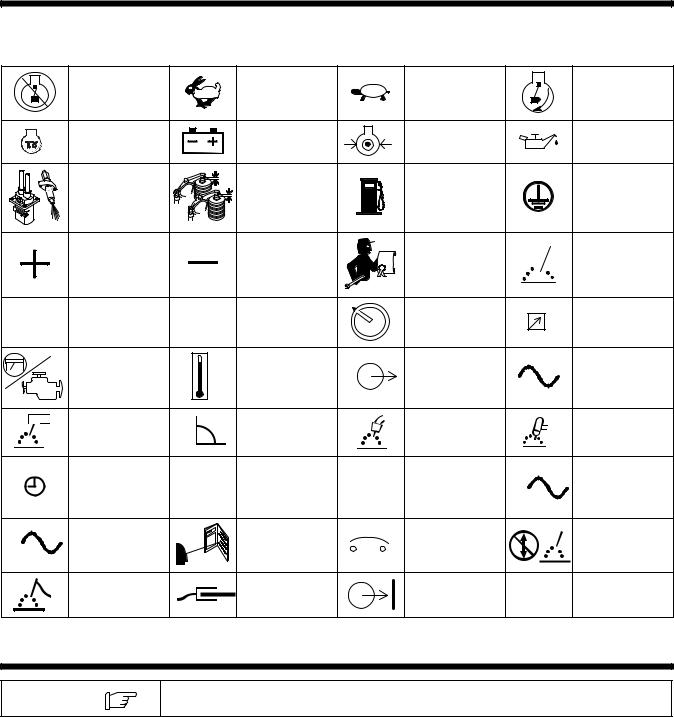
SECTION 3 − DEFINITIONS
3-1. Symbols And Definitions
|
|
Stop Engine |
|
Fast (Run, Weld/ |
|
Slow (Idle) |
|
Start Engine |
|
|
|
Power) |
|
|
|||
|
|
|
|
|
|
|
|
|
|
|
Starting Aid |
|
Battery (Engine) |
|
Engine Oil |
|
Engine Oil |
|
|
|
|
Pressure |
|
|||
|
|
|
|
|
|
|
|
|
|
|
Check Injectors/ |
|
Check Valve |
|
Fuel |
|
Protective Earth |
|
|
Pump |
|
Clearance |
|
|
(Ground) |
|
|
|
|
|
|
|
|||
|
|
Positive |
|
Negative |
|
Certified/Trained |
|
Welding Arc |
|
|
|
|
Mechanic |
|
|||
|
A |
|
V |
|
|
|
|
|
|
Amperes |
Volts |
|
Panel/Local |
|
Remote |
||
|
|
|
|
|
||||
|
|
|
|
Air Temperature Or |
|
|
|
Alternating |
|
|
Engine |
|
Engine |
|
Output |
|
|
|
|
|
|
|
Current |
|||
|
|
|
|
Temperature |
|
|
|
|
|
|
|
|
|
|
|
|
|
|
|
Stick (SMAW) |
|
Constant Current |
|
MIG (GMAW) |
|
TIG (GTAW) |
|
|
Welding |
|
(CC) |
|
Welding |
|
|
|
|
|
|
|
|
|||
|
|
Time |
h |
Hours |
s |
Seconds |
1 |
Single Phase |
|
|
|
|
|
||||
3 |
|
Three Phase |
|
Read Operator’s |
|
Circuit Breaker |
|
Do Not Switch |
|
|
Manual |
|
|
While Welding |
|||
|
|
|
|
|
|
|||
|
|
Electrode |
|
Work Connection |
|
Contactor On |
|
|
|
|
Connection |
|
|
|
|
||
|
|
|
|
|
|
|
|
SECTION 4 − SPECIFICATIONS
NOTE
A CC/DC model is shown in this manual.
Return To Table Of Contents |
OM-491 Page 9 |
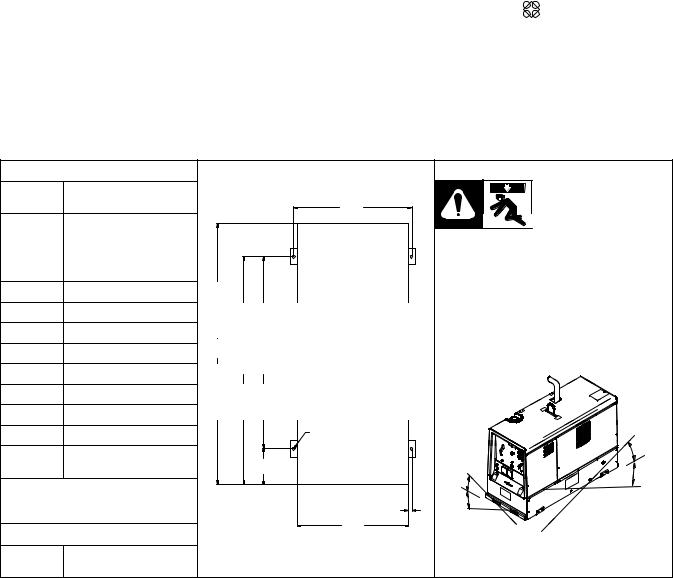
4-1. Weld, Power, And Engine Specifications
|
|
|
Maximum |
|
|
|
|
Welding |
Weld Output |
Rated Welding |
Open- |
Generator Power |
Engine |
Fuel |
|
Mode |
Range |
Output |
Circuit |
Rating |
Capacity |
||
|
|||||||
|
|
|
Voltage |
|
|
|
|
|
|
|
|
|
|
|
|
|
55 − 600 A |
|
|
Standard |
|
|
|
|
|
95 |
Single-Phase, |
|
|
||
|
(CC Models) |
|
|
|
|||
CC/DC |
|
4 kVA/kW, 34/17 A, |
|
|
|||
|
400 A, 40 Volts DC, |
|
|
|
|||
20 − 600 A |
|
120/240 V AC, |
Perkins |
|
|||
|
|
|
|||||
|
(CC/CV Models) |
100% Duty Cycle |
|
50/60 Hz |
|
|
|
|
|
500 A, 40 volts DC, |
|
Three-Phase Generator |
Perkins 3.1524 |
25 gal |
|
|
|
60% Duty Cycle |
|
Option* |
Water-Cooled, |
(95 L) |
|
CV/DC |
|
600 A, 30 Volts DC, |
|
Single-Phase/Three-Phase, |
Three-Cylinder, |
|
|
(CC/CV |
14 − 40 V |
40% Duty Cycle |
56 |
12/20 kVA/kW, 50/48A, |
45 HP Diesel Engine |
|
|
Models |
|
120/240 VAC, 60 Hz |
|
|
|||
|
|
|
|
|
|||
|
|
|
*In Addition To Standard |
|
|
||
Only) |
|
|
|
|
|
||
|
|
|
|
4 kVA/kW Generator Power |
|
|
|
|
|
|
|
|
|
|
4-2. Dimensions, Weights, And Operating Angles
|
Dimensions |
|
|
|
|
Height |
50 in (1270 mm) |
|
|
|
|
(to top of muffler) |
|
G |
|
|
|
|
|
|
|
||
|
|
|
|
|
|
|
28-1/2 in (724 mm) |
|
|
|
|
Width |
(mtg. brackets turned in) |
|
|
Y Do not exceed tilt angles or engine could |
|
|
|
|
|||
|
30-3/4 in (781 mm) |
|
|
be damaged or unit could tip. |
|
|
(mtg. brackets turned out) |
|
|
Y Do not move or operate unit where it could |
|
|
|
|
|
||
Depth |
65-1/8 in (1654 mm) |
|
|
tip. |
|
|
|
|
|
||
A |
65-1/8 in (1654 mm) |
|
|
|
|
B* |
56 in (1422 mm) |
|
|
|
|
C* |
46-1/2 in (1181) |
A |
|
|
|
B |
C |
|
|
||
D* |
9-5/8 in (244 mm) |
|
|
||
|
|
|
|
||
E |
27-1/2 in (699 mm) |
|
|
|
|
F |
1 in (25 mm) |
|
|
|
|
G |
29-1/2 in (743 mm) |
|
H |
|
30° |
|
|
|
|||
|
9/16 in (14 mm) Dia. |
|
|
|
|
H |
|
D |
|
|
|
4 Holes |
|
|
30° |
||
|
|
20° |
|||
|
|
|
Front Panel End |
||
|
|
|
|
||
* With mounting brackets in center |
|
|
20° |
|
|
position. Dimensions vary with |
|
|
|
||
location of mounting brackets. |
|
|
F |
|
|
|
E |
|
|
||
|
Weight |
|
|
|
|
|
|
|
|
|
|
w/ Perkins |
No fuel: 1670 lb (758 kg) |
|
|
802 161-A |
|
3.1524 |
w/fuel: 1860 lb (844 kg) |
|
|
|
|
OM-491 Page 10 |
Return To Table Of Contents |
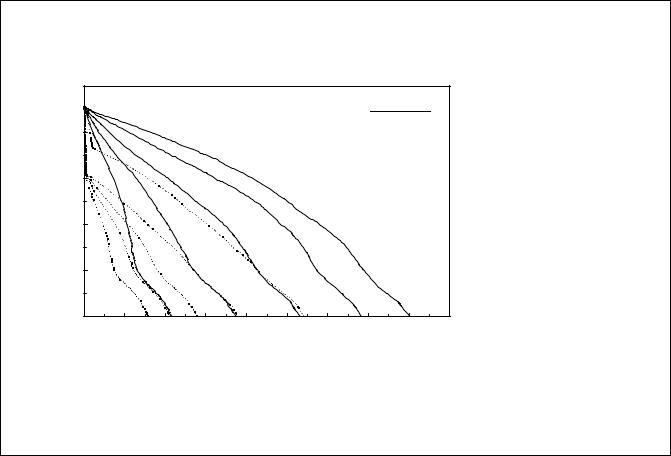
4-3. Volt-Ampere Curves For CC Models
The volt-ampere curve shows the minimum and maximum voltage and amperage output capabilities of the welding generator. Curves of all other settings fall between the curves shown.
|
100 |
|
|
|
|
|
|
Ranges |
|
|
|
|
|
|
|
|
|
|
|
||
|
80 |
|
|
|
|
|
|
300−Max |
|
|
|
|
|
|
|
|
|
185−425 |
|
||
|
|
|
|
|
|
|
|
|
||
|
|
|
|
|
|
|
|
125−320 |
|
|
|
60 |
|
|
|
|
|
|
85−190 |
|
|
VOLTS |
|
|
|
|
|
|
|
55−90 |
|
|
|
|
|
|
|
|
|
|
|
||
40 |
|
|
|
|
|
|
|
|
|
|
DC |
|
|
|
|
|
|
|
|
|
|
|
20 |
|
|
|
|
|
|
|
|
|
|
0 |
|
|
|
|
|
|
|
|
|
|
0 |
100 |
200 |
300 |
400 |
500 |
600 |
700 |
800 |
900 |
DC AMPERES
203 412
Return To Table Of Contents |
OM-491 Page 11 |
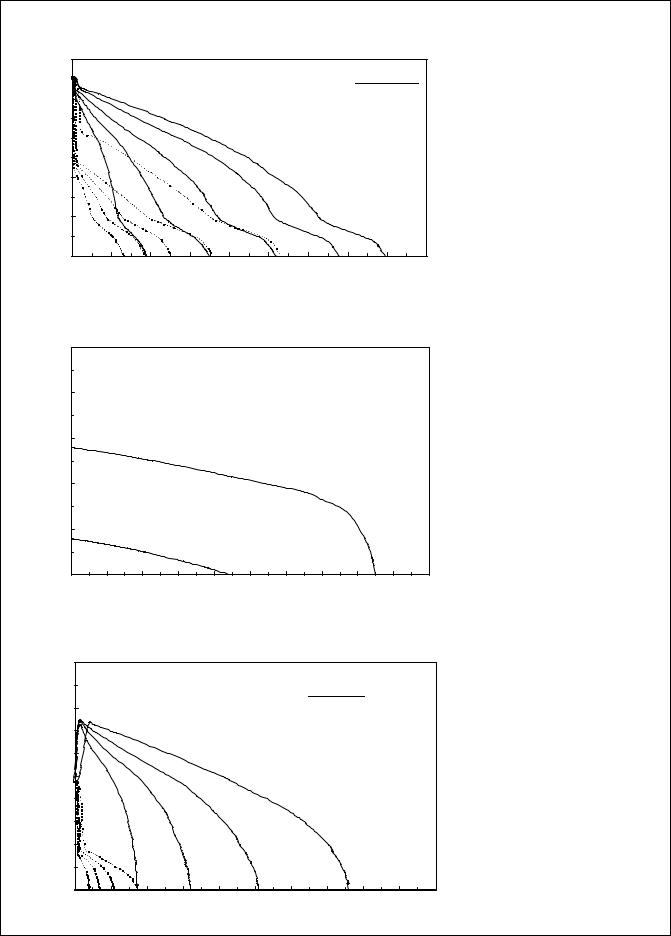
4-4. Volt-Ampere Curves For CC/CV Models
A. Stick Mode
|
100 |
|
|
|
|
|
|
Ranges |
|
|
|
|
|
|
|
|
|
|
|
||
|
80 |
|
|
|
|
|
|
300−Max |
|
|
|
|
|
|
|
|
|
185−425 |
|
||
|
|
|
|
|
|
|
|
|
||
VOLTS |
60 |
|
|
|
|
|
|
125−320 |
|
|
|
|
|
|
|
|
85−190 |
|
|||
|
|
|
|
|
|
|
|
55−90 |
|
|
40 |
|
|
|
|
|
|
|
|
|
|
DC |
|
|
|
|
|
|
|
|
|
|
|
|
|
|
|
|
|
|
|
|
|
|
20 |
|
|
|
|
|
|
|
|
|
|
0 |
|
|
|
|
|
|
|
|
|
|
0 |
100 |
200 |
300 |
400 |
500 |
600 |
700 |
800 |
900 |
DC AMPERES
B. MIG Mode
|
100 |
|
|
|
|
|
|
|
|
|
|
|
80 |
|
|
|
|
|
|
|
|
|
|
VOLTS |
60 |
|
MAX |
|
|
|
|
|
|
|
|
|
|
|
|
|
|
|
|
|
|||
40 |
|
|
|
|
|
|
|
|
|
|
|
DC |
|
|
|
|
|
|
|
|
|
|
|
|
|
|
|
|
|
|
|
|
|
|
|
|
20 |
|
MIN |
|
|
|
|
|
|
|
|
|
|
|
|
|
|
|
|
|
|
|
|
|
0 |
|
|
|
|
|
|
|
|
|
|
|
0 |
100 |
200 |
300 |
400 |
500 |
600 |
700 |
800 |
900 |
1000 |
DC AMPERES
C. TIG Mode
|
100 |
|
|
|
|
|
|
|
|
|
|
|
|
|
|
|
|
|
|
Ranges |
|
|
|
|
80 |
|
|
|
|
|
60−310 |
|
|
|
|
|
|
|
|
|
|
|
40−200 |
|
|
|
|
|
|
|
|
|
|
|
30−130 |
|
|
|
|
VOLTS |
60 |
|
|
|
|
|
|
20−70 |
|
|
|
40 |
|
|
|
|
|
|
|
|
|
|
|
DC |
|
|
|
|
|
|
|
|
|
|
|
|
|
|
|
|
|
|
|
|
|
|
|
|
20 |
|
|
|
|
|
|
|
|
|
|
|
0 |
|
|
|
|
|
|
|
|
|
|
|
0 |
50 |
100 |
150 |
200 |
250 |
300 |
350 |
400 |
450 |
500 |
DC AMPERES
The volt-ampere curves show the minimum and maximum voltage and amperage output capabilities of the welding generator. Curves of all other settings fall between the curves shown.
203 414 / 203 415 / 203 413
OM-491 Page 12 |
Return To Table Of Contents |
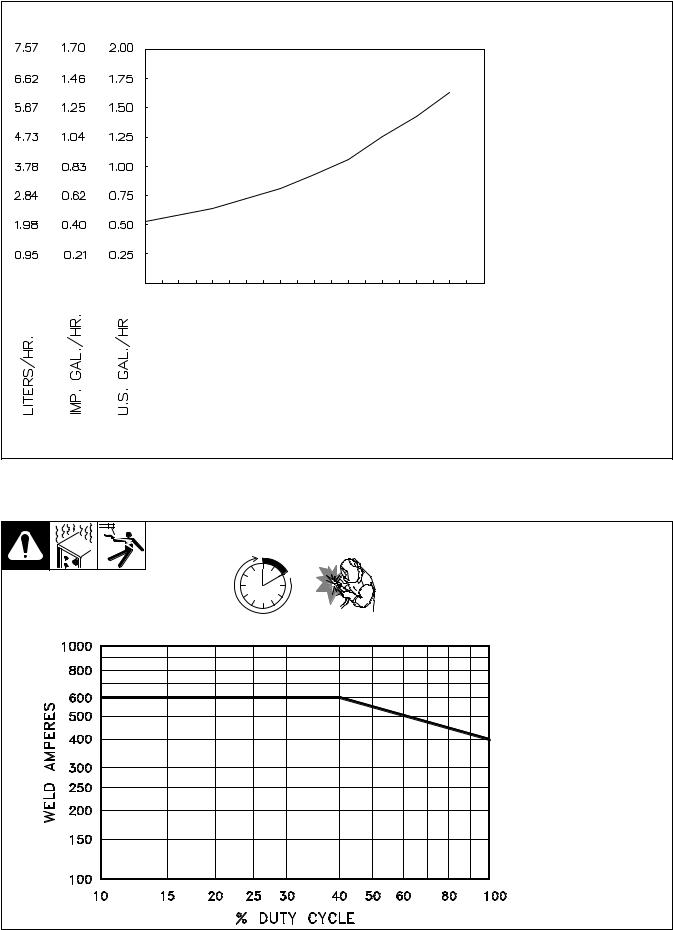
4-5. Fuel Consumption
The curve shows typical fuel use under weld or power loads.
1800 RPM
0 |
|
IDLE |
|
|
|
|
|
|
|
|
|
|
|
|
|
|
|
|
|
|
|
||
|
|
|
|
|
|
|
|
|
|
|
|
0 |
50 |
100 |
150 |
200 |
250 |
300 |
350 |
400 |
450 |
500 |
|
|
|
DC WELD AMPERES AT 100% DUTY CYCLE |
|
|
|||||||
193 093
4-6. Duty Cycle And Overheating
100% Duty Cycle At 400 Amperes |
Duty Cycle is percentage of 10 min- |
|
utes that unit can weld at rated load |
|
without overheating. |
Y Exceeding duty cycle can damage unit and void warranty.
Continuous Welding
089 697-D
Return To Table Of Contents |
OM-491 Page 13 |
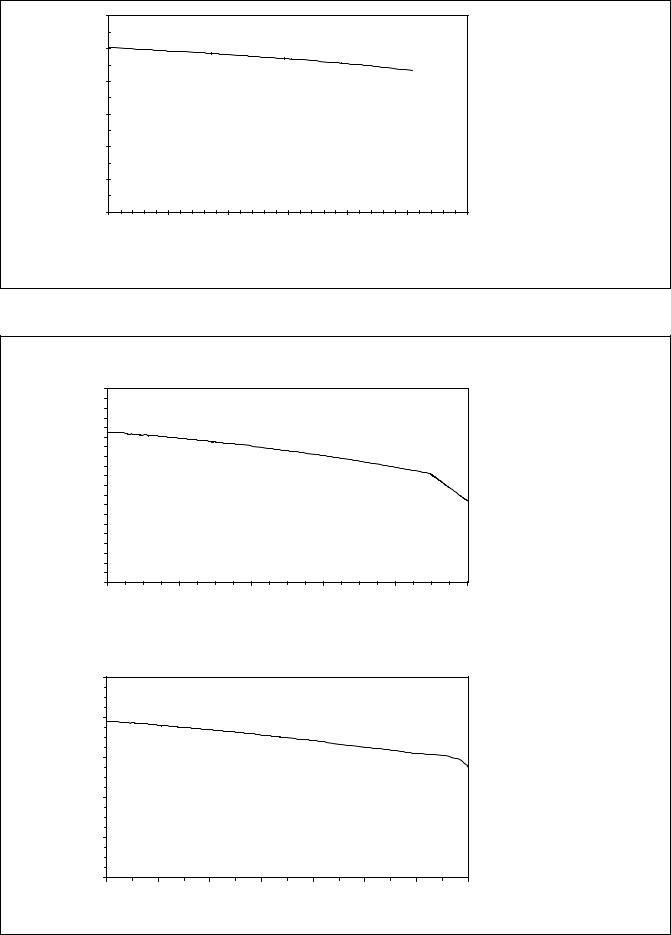
4-7. AC Generator Power Curve
|
150 |
300 |
|
|
|
|
|
|
|
125 |
250 |
|
|
|
|
|
|
VOLTS |
100 |
200 |
|
|
|
|
|
|
75 |
150 |
|
|
|
|
|
|
|
AC |
|
|
|
|
|
|
||
|
|
|
|
|
|
|
|
|
|
50 |
100 |
|
|
|
|
|
|
|
25 |
50 |
|
|
|
|
|
|
|
0 |
0 |
|
|
|
|
|
|
|
|
0 |
5 |
10 |
15 |
20 |
25 |
30 |
|
|
|
|
AC AMPERES IN 240V MODE |
|
|
||
|
|
0 |
10 |
20 |
30 |
40 |
50 |
60 |
|
|
|
|
AC AMPERES IN 120V MODE |
|
|
||
The ac power curve shows the generator power in amperes available at the 120 and 240 volt receptacles.
193 018
4-8. Optional Three-Phase Generator Curves
A. 12 kVA/kW Single-Phase AC Output (No Weld Load)
AC VOLTS

140 280
135 270
130 260
125 
 250
250
120 240
115 230
110 
 220
220
105 210
100 
 200
200
95 190
90 
 180
180
0 |
20 |
40 |
60 |
80 |
100 |
AC AMPERES
B. 20 kVA/kW Three-Phase AC Output (No Weld Load)
|
280 |
|
|
|
|
|
|
|
VOLTS |
260 |
|
|
|
|
|
|
|
240 |
|
|
|
|
|
|
|
|
|
|
|
|
|
|
|
|
|
AC |
220 |
|
|
|
|
|
|
|
|
|
|
|
|
|
|
|
|
|
200 |
|
|
|
|
|
|
|
|
180 |
|
|
|
|
|
|
|
|
0 |
10 |
20 |
30 |
40 |
50 |
60 |
70 |
|
|
|
|
AC AMPERES |
|
|
|
|
The ac power curves show the generator power available in amperes at the single-phase 120/240 volt receptacle or three-phase 240 volt terminals.
197 472 / 197 473
OM-491 Page 14 |
Return To Table Of Contents |
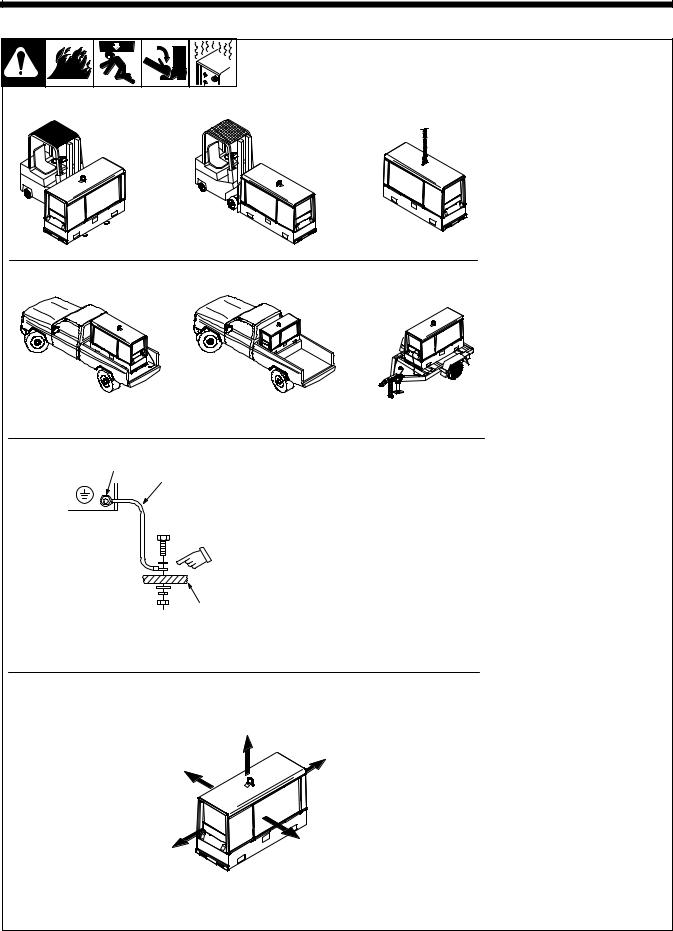
|
SECTION 5 − INSTALLATION |
|
|
|
|
|
||
5-1. Installing Welding Generator |
|
|
|
|
|
|
||
|
|
|
Y Always securely fasten weld- |
|||||
|
|
|
|
ing generator onto transport |
||||
|
|
|
|
vehicle or trailer and comply |
||||
Movement |
|
|
|
with all DOT and other applica- |
||||
|
|
|
ble codes. |
|
|
|||
|
|
|
Y Always |
ground |
generator |
|||
|
|
|
|
frame to vehicle frame to pre- |
||||
|
|
|
|
vent electric shock and static |
||||
|
|
|
|
electricity hazards. |
|
|||
|
|
|
Y If unit does not have GFCI re- |
|||||
|
OR |
OR |
|
ceptacles, use GFCI-protected |
||||
|
|
extension cord. |
|
|||||
|
|
|
|
|
||||
|
|
|
. See Section 5-2 for mounting in- |
|||||
|
|
|
|
formation. |
|
|
|
|
|
|
|
Grounding: |
|
|
|
||
Location |
|
|
1 |
Equipment Grounding Terminal |
||||
|
|
|
(On Front Panel) |
|
||||
|
|
|
|
|
||||
|
|
|
2 Grounding Cable (Not Supplied) |
|||||
|
|
|
3 |
Metal Vehicle Frame |
|
|||
|
|
|
Connect |
cable |
from |
equipment |
||
|
|
|
ground terminal to metal vehicle |
|||||
|
OR |
OR |
frame. Use #10 AWG or larger insu- |
|||||
|
lated copper wire. |
|
|
|||||
Grounding |
|
|
|
|
|
|
|
|
|
1 |
|
|
|
|
|
|
|
GND/PE |
2 |
|
|
|
|
|
|
|
|
|
|
|
|
|
|
|
|
|
|
Electrically bond generator frame to |
|
|
|
|
|
|
|
|
vehicle frame by metal-to-metal contact. |
|
|
|
|
|
|
|
3 |
Y Bed liners, shipping skids, and some running |
|
|
|
|
|
|
|
|
gears insulate the welding generator from the |
|
|
|
|
|
|
|
|
vehicle frame. Always connect a ground wire |
|
|
|
|
|
|
|
|
from the generator equipment grounding termi- |
|
|
|
|
|
|
|
|
nal to bare metal on the vehicle frame as shown. |
|
|
|
|
|
|
Airflow Clearance |
|
|
|
|
|
|
|
|
|
|
18 in |
|
|
|
|
|
|
|
|
(460 mm) |
|
|
|
|
|
|
|
|
18 in |
|
|
|
|
|
|
|
18 in |
(460 mm) |
|
|
|
|
|
|
|
(460 mm) |
|
|
|
|
|
|
|
|
18 in |
18 in |
|
|
|
|
|
|
|
(460 mm) |
|
|
|
|
|
|
|
|
(460 mm) |
|
|
|
|
|
|
|
|
|
|
|
|
|
|
|
|
|
|
install3 6/03 − Ref. 800 652 / Ref. 800 477-A / 803 274 |
||||||
Return To Table Of Contents |
OM-491 Page 15 |
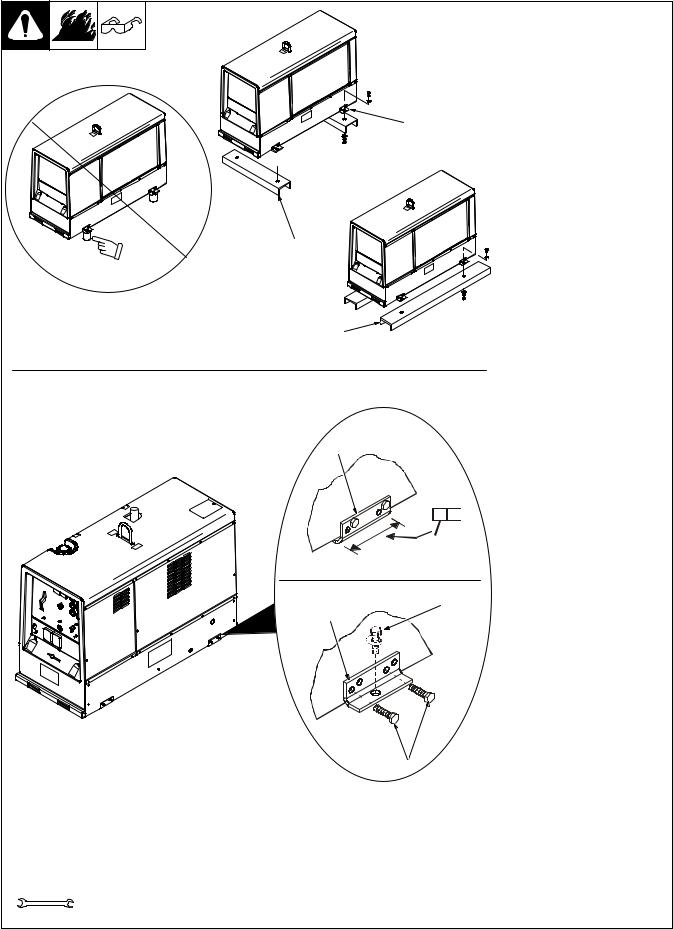
5-2. Mounting Welding Generator
Supporting The Unit
2
OR
1
Inadequate support.
Y Do not use flexible mounts.
1
Using Mounting Brackets
2
Welding Unit In Place
Bolting Unit In Place
3
2
4
Tools Needed:
9/16 in
YDo not weld on base. Welding on base can cause fuel tank fire or explosion. Weld only on the four mounting brackets or bolt unit down.
YDo not mount unit by supporting the base only at the four mounting brackets. Use cross-supports to adequately support unit and prevent damage to base.
Mounting Surface:
1Cross-Supports
2Mounting Brackets (Supplied)
Mount unit on flat surface or use cross-supports to support base. Secure unit with mounting brackets.
31/2 in Bolt And Washer
(Minimum − Not Supplied)
43/8-16 x 1 in Screws
(Supplied)
To Bolt Unit In Place:
Remove hardware securing the four mounting brackets to the base.
Reverse brackets and reattach to base with original hardware.
Mount unit to truck or trailer with 1/2 in (12 mm) or larger hardware (not supplied).
To Weld Unit In Place:
Weld unit to truck or trailer only at the four mounting brackets.
install3 6/03 803 274 / 190 250-A / 803 231
OM-491 Page 16 |
Return To Table Of Contents |
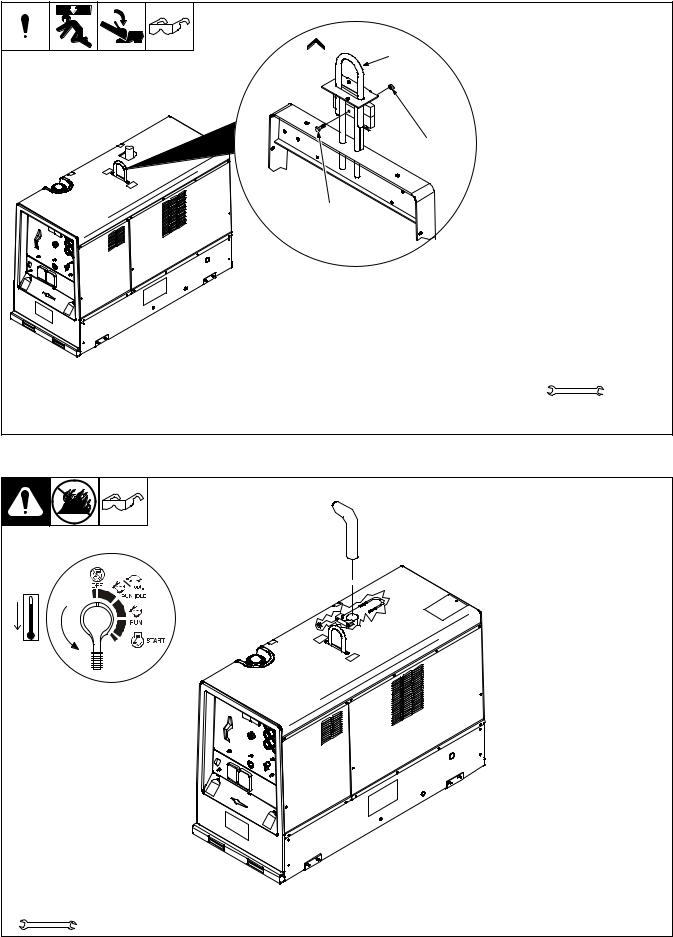
5-3. Using Lifting Eye
|
|
|
|
|
|
1 |
Lifting Eye |
|
|
|
|
|
|
||
|
|
|
|
|
|
2 |
Nut |
|
|
|
|
|
|
||
|
|
|
|
|
1 |
3 |
Carriage Bolt |
|
|
|
|
|
|||
|
|
|
|
|
|||
|
|
Raise lifting eye until it snaps in |
|||||
|
|
|
|
|
|
||
|
|
|
|
|
|
place. Lower lifting eye when not |
|
|
|
|
|
|
|
||
|
|
|
|
|
|
needed. |
|
|
|
|
|
|
|
To lock the lifting eye in the upright |
|
|
|
|
|
|
|
position, insert a 3/8-16 x 1-1/2 in |
|
|
|
|
|
|
|
carriage bolt through slot in bracket |
|
2 |
and secure with nut (bolt and nut not |
||||||
|
|
|
|
|
|
supplied). |
|
3
Tools Needed:
Ref. 802 169-F
5-4. Installing Exhaust Pipe
Y Stop engine and let cool.
. Point exhaust pipe in desired direction but always away from front panel and direction of travel.
Tools Needed:
1/2 in |
Ref. 802 169-E / Ref. 202 705 |
Return To Table Of Contents |
OM-491 Page 17 |
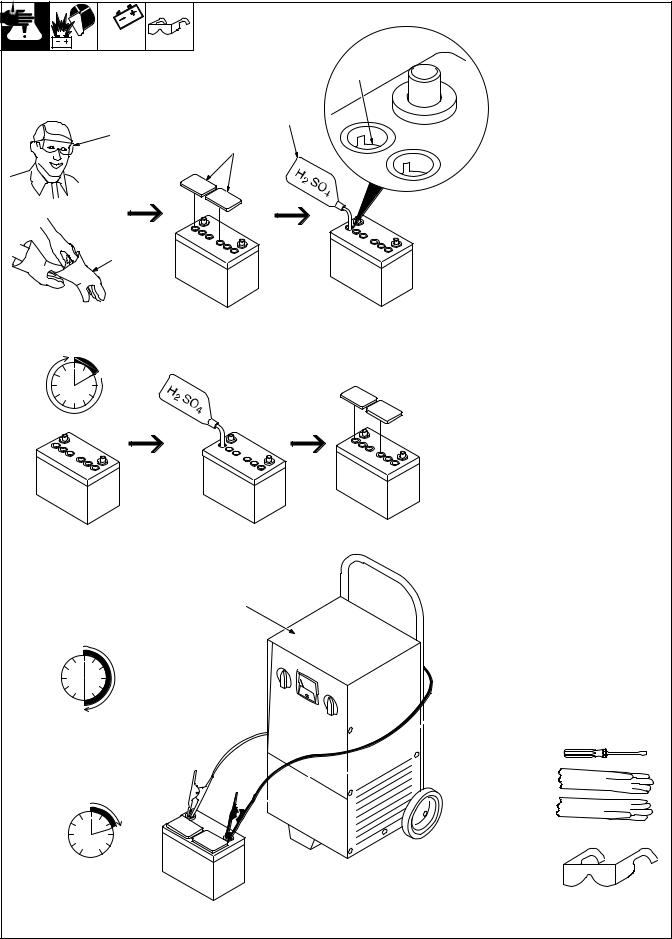
5-5. Activating The Dry Charge Battery (If Applicable) |
|
|
|
|
|
Remove battery from unit. |
|
|
|
1 |
Eye Protection − Safety |
|
|
|
Glasses Or Face Shield |
|
|
2 |
Rubber Gloves |
|
5 |
3 |
Vent Caps |
|
|
4 |
Sulfuric Acid Electrolyte |
|
|
|
(1.265 Specific Gravity) |
|
4 |
5 |
Well |
1 |
3 |
Fill |
each cell with electrolyte to |
|
bottom of well (maximum). |
||
|
|
Y Do not overfill battery cells. |
|
|
|
Wait ten minutes and check electro- |
|
|
|
lyte level. If necessary, add electro- |
|
|
|
lyte to raise to proper level. Reins- |
|
|
|
tall vent caps. |
|
|
|
6 |
Battery Charger |
2 |
|
Y Read and follow all instruc- |
|
|
|
tions supplied with battery |
|
|
|
|
|
|
|
|
charger. |
|
|
Charge battery for 12 minutes at 30 |
|
|
|
amperes or 30 minutes at 5 am- |
|
|
|
peres. Disconnect charging cables |
|
|
|
and install battery. |
|
|
|
. When electrolyte is low, add |
|
|
|
|
only distilled water to cells to |
|
|
|
maintain proper level. |
|
6 |
|
|
5 A For 30 Minutes |
|
|
Tools Needed: |
OR |
|
|
|
|
+ |
|
|
|
− |
|
rubber gloves |
30 A For 12 Minutes |
|
|
|
|
|
|
glasses |
|
|
|
drybatt1 1/98 − 0886 |
OM-491 Page 18 |
Return To Table Of Contents |
|
|
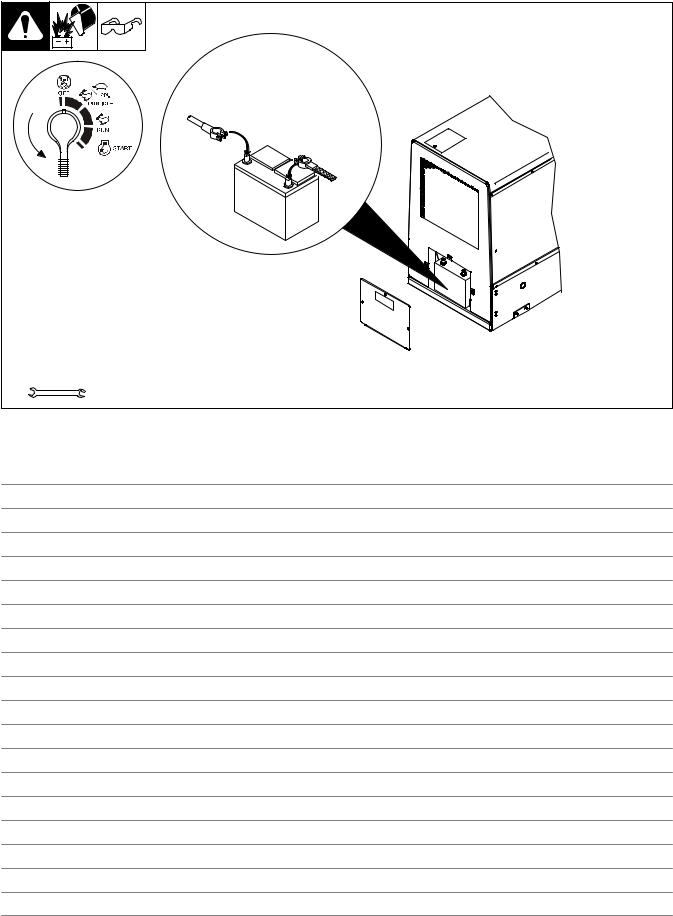
5-6. Connecting The Battery
. Reinstall cover after connecting battery.
Y Connect Negative (−) Cable Last.
+
−
Tools Needed:
1/2 in |
802 168-E / Ref. 202 705 / 802 313 / S-0756-C |
|
Notes
Return To Table Of Contents |
OM-491 Page 19 |
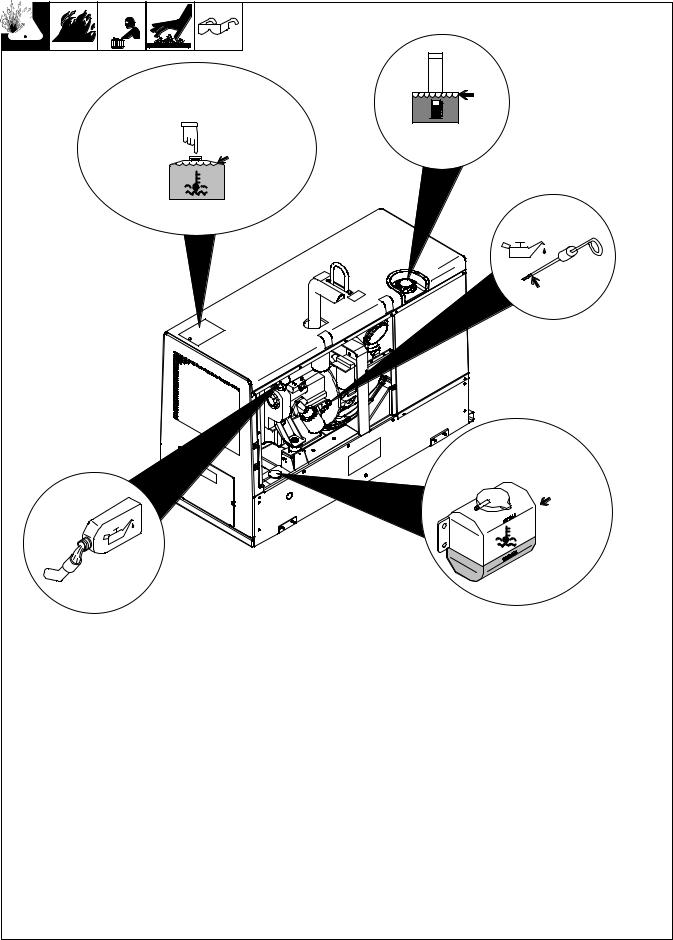
5-7. Engine Prestart Checks
Full
Check radiator coolant level when fluid is low in recovery tank.
Diesel
Full
Capacity: 12 qt (11.4L)
Full
Coolant Recovery Tank
Hot Full
 Cold Full
Cold Full
. Check all engine fluids daily.
Engine must be cold and on a level surface. Unit is shipped with 20W break-in oil.
The Automatic shutdown system stops engine if fuel level or oil pressure is too low, or coolant temperature is too high.
.This unit has a low oil pressure shutdown switch. However, some conditions may cause engine damage before the engine shuts down. Check oil level often and do not use the oil pressure shutdown system to monitor oil level.
Follow run-in procedure in engine manual. If unburned fuel and oil collect in exhaust pipe during run-in, see Section 11.
Fuel
YDo not use gasoline. Gasoline will damage engine.
The unit is shipped with enough fuel to prevent air from entering fuel system but not enough fuel to prevent low fuel shutdown.
Add fresh diesel fuel before starting to prevent low fuel shutdown (see engine mainte-
OM-491 Page 20
nance label for fuel specifications). Leave filler neck empty to allow room for expansion.
Do not run out of fuel or air will enter fuel system and cause starting problems. See engine manual to bleed air from fuel system.
Oil
After fueling, check oil with unit on level surface. If oil is not up to full mark on dipstick, add oil (see maintenance label).
Coolant
Check coolant level in radiator before starting unit the first time. If necessary, add coolant to radiator until coolant level is at bottom of filler neck.
Check coolant level in recovery tank daily.
If necessary, add coolant to recovery tank until coolant level is between Cold Full and
Hot Full levels. If recovery tank coolant level was low, also check coolant level in radiator.
Add coolant if level is below bottom of radiator filler neck.
Unit is shipped with an engine coolant mixture of water and ethylene glycol base anti-
Return To Table Of Contents
Ref. 802 168-E
freeze rated to −34 ° F (−37 ° C). Add antifreeze to mixture if using the unit in temperatures below −34 ° F (−37 ° C).
Keep radiator and air intake clean and free of dirt.
YIncorrect engine temperature can damage engine. Do not run engine without a properly working thermostat and radiator cap.
.To improve cold weather starting:
Use Starting Aid switch (see Section
6-1 or 7-1).
Keep battery in good condition. Store battery in warm area.
Use fuel formulated for cold weather
(diesel fuel can gel in cold weather).
Contact local fuel supplier for fuel information.
Use correct grade oil for cold weather
(see Section 9-2).
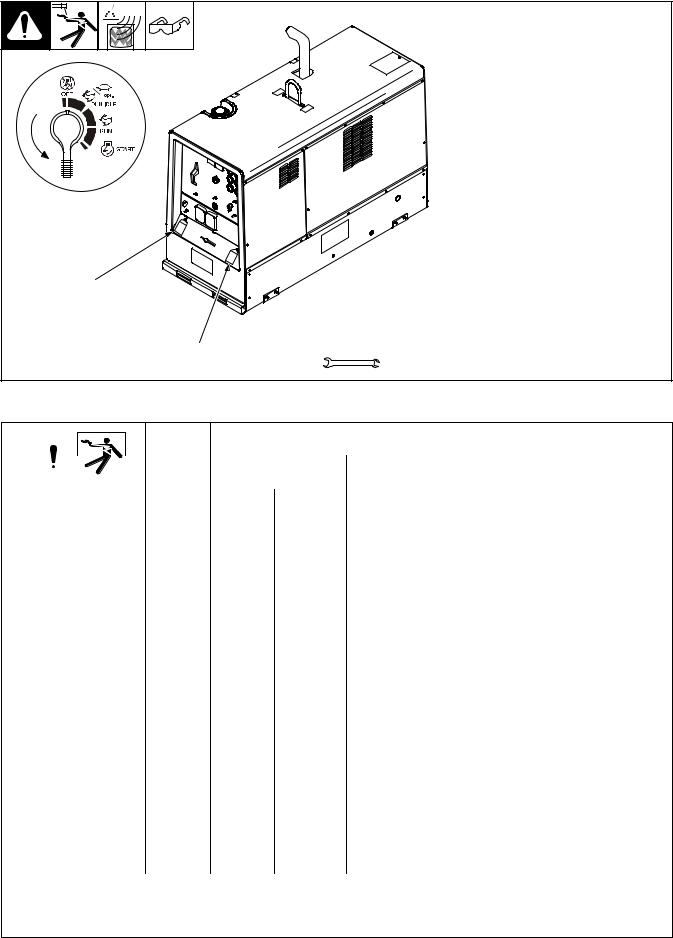
5-8. |
Connecting To Weld Output Terminals |
|
|
|
Y Stop engine. |
|
|
1 Positive (+) Weld Output Terminal |
|
|
2 Negative (−) Weld Output T erminal |
|
|
For Stick and TIG welding Direct Cur- |
|
|
rent Electrode Positive (DCEP), con- |
|
|
nect electrode holder cable to Positive |
|
|
(+) terminal on left and work cable to |
|
|
Negative (−) terminal on right. |
|
|
For Direct Current Electrode Negative |
|
|
(DCEN), reverse cable connections. |
|
|
If equipped with optional polarity switch, |
|
|
connect electrode holder cable to Elec- |
|
|
trode terminal on left and work cable to |
|
|
Work terminal on right. |
|
|
For MIG and FCAW welding Direct Cur- |
|
|
rent Electrode Positive (DCEP) on CC/ |
|
|
CV models, connect wire feeder cable to |
|
|
Positive (+) terminal on left and work |
|
|
cable to Negative (−) terminal on right. |
|
|
Use Process/Contactor switch to select |
|
1 |
type of weld output (see Section 7-3). |
|
|
For Direct Current Electrode Negative |
|
|
(DCEN), reverse cable connections. |
|
|
If equipped with optional polarity switch, |
|
Tools Needed: |
connect wire feeder cable to Electrode |
|
2 |
terminal on left and work cable to Work |
|
3/4 in |
terminal on right. |
|
|
Ref. 802 169-E |
5-9. |
Selecting Weld Cable Sizes* |
|
|
|
|
|
|
Weld Cable Size** and Total Cable (Copper) Length in Weld Circuit |
|||||||
|
|
|
|
|
||||||||
|
|
|
|
|
|
|
Not Exceeding*** |
|
|
|
||
|
|
|
|
|
|
|
|
|
|
|
|
|
|
|
|
|
|
100 ft (30 m) or Less |
150 ft |
200 ft |
250 ft |
300 ft |
350 ft |
400 ft |
|
|
|
|
|
|
(45 m) |
(60 m) |
(70 m) |
(90 m) |
(105 m) |
(120 m) |
||
|
Weld Output |
|
|
|
||||||||
|
|
|
|
|
|
|
|
|
|
|||
|
|
|
|
|
|
|
|
|
|
|||
|
Terminals |
|
|
|
|
|
|
|
|
|
||
Y Stop engine before |
Welding |
10 − 60% |
60 − 100% |
|
|
|
|
|
|
|||
connecting to weld out- |
Duty |
Duty |
|
10 − 100% Duty Cycle |
|
|
||||||
put terminals. |
Amperes |
|
|
|
||||||||
Cycle |
Cycle |
|
|
|
|
|
|
|||||
|
|
|
|
|
|
|
|
|
|
|
||
YDo not use worn, damaged, undersized, or poorly spliced cables.
100 |
4 (20) |
4 (20) |
4 (20) |
3 (30) |
2 (35) |
1 (50) |
1/0 (60) |
1/0 (60) |
||
|
|
|
|
|
|
|
|
|
|
|
150 |
3 (30) |
3 (30) |
2 (35) |
1 (50) |
1/0 (60) |
2/0 (70) |
3/0 (95) |
3/0 (95) |
||
|
|
|
|
|
|
|
|
|
|
|
200 |
3 (30) |
2 (35) |
1 (50) |
1/0 (60) |
2/0 (70) |
3/0 (95) |
4/0 (120) |
4/0 (120) |
||
|
|
|
|
|
|
|
|
|
|
|
250 |
2 (35) |
1 (50) |
1/0 (60) |
2/0 (70) |
3/0 (95) |
4/0 (120) |
2 ea. 2/0 |
2 ea. 2/0 |
||
(2x70) |
(2x70) |
|||||||||
|
|
|
|
|
|
|
|
|||
|
|
|
|
|
|
|
|
|
|
|
300 |
1 (50) |
1/0 (60) |
2/0 (70) |
3/0 (95) |
4/0 (120) |
2 ea. 2/0 |
2 ea. 3/0 |
2 ea. 3/0 |
||
(2x70) |
(2x95) |
(2x95) |
||||||||
|
|
|
|
|
|
|
||||
|
|
|
|
|
|
|
|
|
|
|
350 |
1/0 (60) |
2/0 (70) |
3/0 (95) |
4/0 (120) |
2 ea. 2/0 |
2 ea. 3/0 |
2 ea. 3/0 |
2 ea. 4/0 |
||
(2x70) |
(2x95) |
(2x95) |
(2x120) |
|||||||
|
|
|
|
|
|
|||||
|
|
|
|
|
|
|
|
|
|
|
400 |
1/0 (60) |
2/0 (70) |
3/0 (95) |
4/0 (120) |
2 ea. 2/0 |
2 ea. 3/0 |
2 ea. 4/0 |
2 ea. 4/0 |
||
(2x70) |
(2x95) |
(2x120) |
(2x120) |
|||||||
|
|
|
|
|
|
|||||
|
|
|
|
|
|
|
|
|
|
|
500 |
2/0 (70) |
3/0 (95) |
4/0 (120) |
2 ea. 2/0 |
2 ea. 3/0 |
2 ea. 4/0 |
3 ea. 3/0 |
3 ea. 3/0 |
||
(2x70) |
(2x95) |
(2x120) |
(3x95) |
(3x95) |
||||||
|
|
|
|
|
||||||
|
|
|
|
|
|
|
|
|
|
|
* This chart is a general guideline and may not suit all applications. If cables overheat (normally you can smell it), use next size larger cable.
**Weld cable size (AWG) is based on either a 4 volts or less drop or a current density of at least 300 circular mils per ampere. ( ) = mm2 for metric use
***For distances longer than those shown in this guide, call a factory applications representative at 920-735-4505.
Return To Table Of Contents
